How to Draw Medusa: A Step-by-Step Guide for Artists
I’ve been drawing for what feels like a lifetime, and my very first subjects were always figures from old myths. There was something about trying to capture a character like Medusa that felt like a true test of skill. Honestly, my first attempts were a mess. I was so focused on making her look scary that the drawings came out flat, more like weird cartoons than the powerful, tragic figure I had in my head. It took me years of obsessing over anatomy and classical sculpture to finally have that ‘aha!’ moment.
In this article
Here’s the secret: to draw Medusa well, you can’t just draw a monster. You have to draw the woman first, and then build the curse around her. It’s a fascinating challenge that combines anatomy, texture, and pure storytelling.
This isn’t just a list of steps to copy. It’s about understanding the structure beneath the skin and the story behind the eyes. Medusa is a favorite subject for a reason—she’s a tough one! How do you balance beauty with terror? How do you make soft skin look believable next to hard, reflective snake scales? This guide walks you through the methods I’ve polished over years of professional work, breaking it all down into something you can actually use.
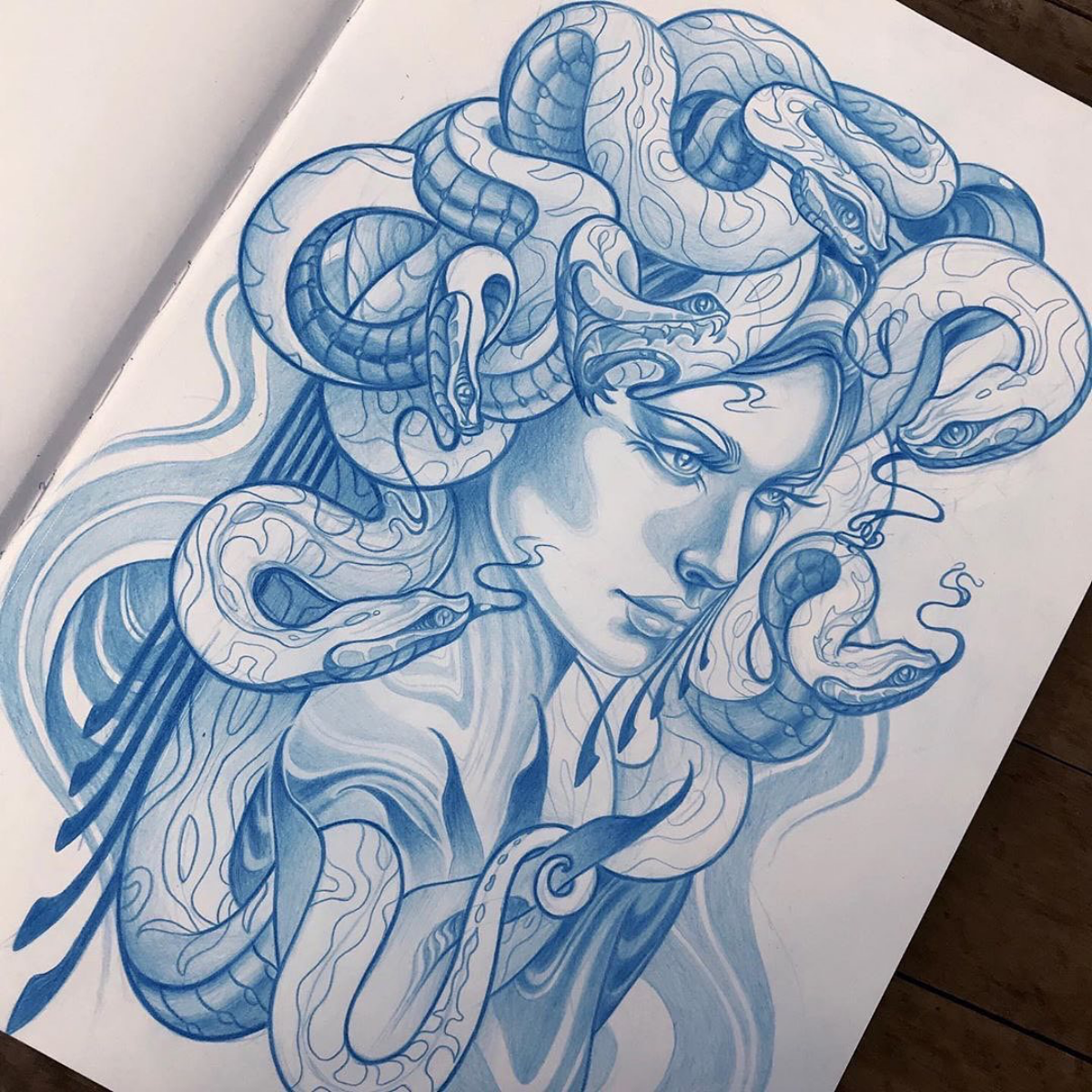
The Foundation: Anatomy Before Artistry
Every great figure drawing is built on a solid foundation. And for any person or creature, that foundation is anatomy. Before you even think about a single snake, you need to get a handle on the human head. So many aspiring artists skip this, jump right to the fun details, and then wonder why their portraits feel lifeless. The life is in the bone and muscle underneath, I promise you.
First, Understand the Human Skull
I keep a small replica skull in my studio, and it’s one of the most useful tools I own. It’s a constant reminder that a face isn’t a flat surface—it’s a complex, three-dimensional form. When I start a drawing of Medusa, I first think of the cranium, that big, round part that holds the brain. Then, I consider the jaw. The way it connects below the ear dictates the entire shape of the lower face. Is her jaw clenched in defiance, or slack with sorrow? The bones tell that story.
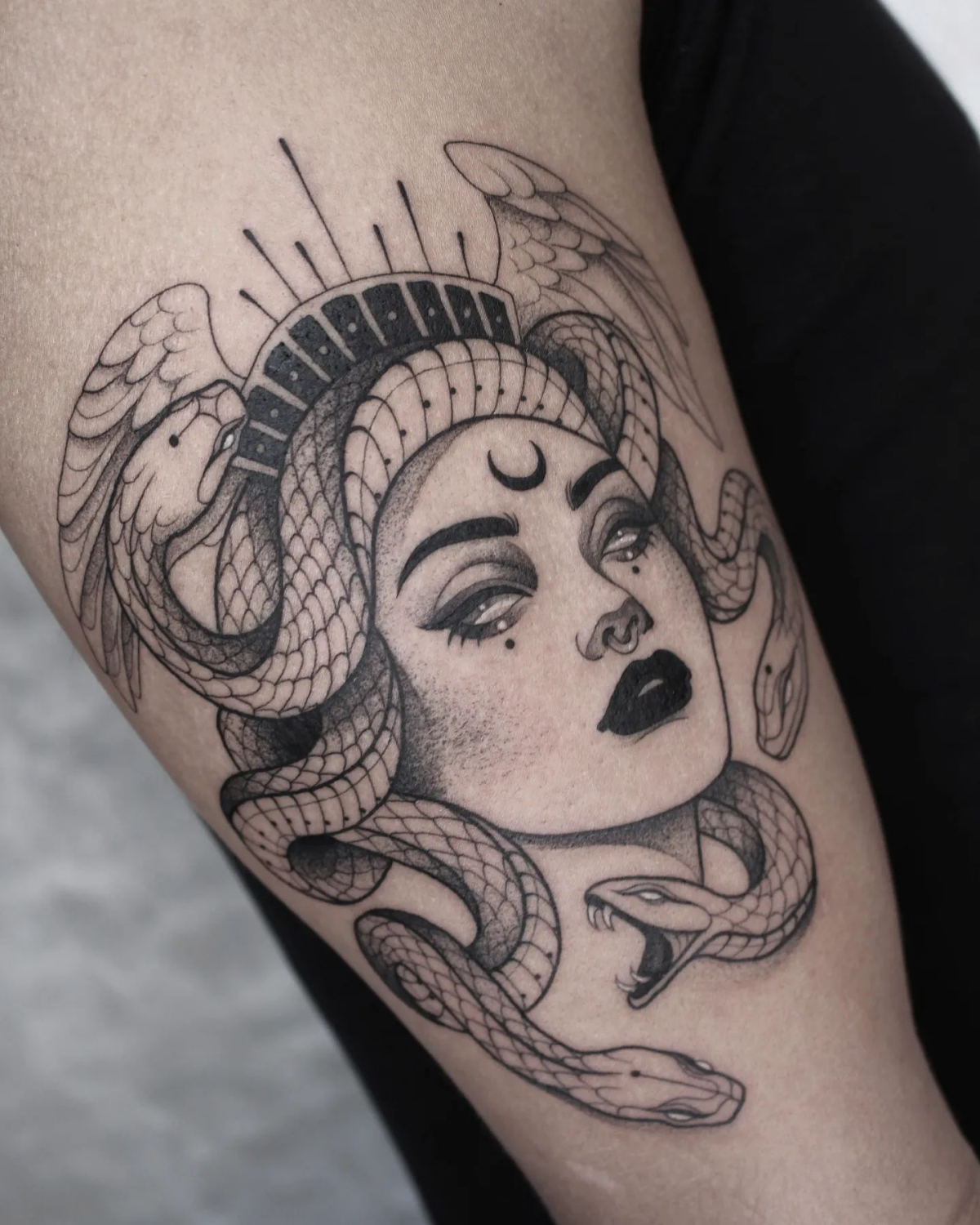
The eye sockets are also a huge deal. They aren’t just circles; they’re hollows where the eyes sit. Understanding this helps you get the placement right and create shadows that look real. Then you have the cheekbones, which create the planes of the face that catch the light. Before drawing a single feature, I lightly sketch these basic structures. It’s like framing a house before you put up the walls.
By the way, you don’t need to spend a fortune on this. You can find decent anatomical skulls on sites like Amazon or in art supply stores for between $20 and $50. Or, for a completely free option, check out a site like Sketchfab. It has tons of 3D models you can rotate and study right on your screen!
Next, the Anatomy of a Snake
Once the human foundation is solid, it’s time to think about the snakes. And they are NOT just curvy, noodly lines. Each snake is an animal with its own anatomy. I once spent a whole month just drawing snakes from reference photos to get this right. Their bodies are powerful tubes of muscle, and they don’t just bend randomly. They coil, twist, and bunch up in very specific ways.
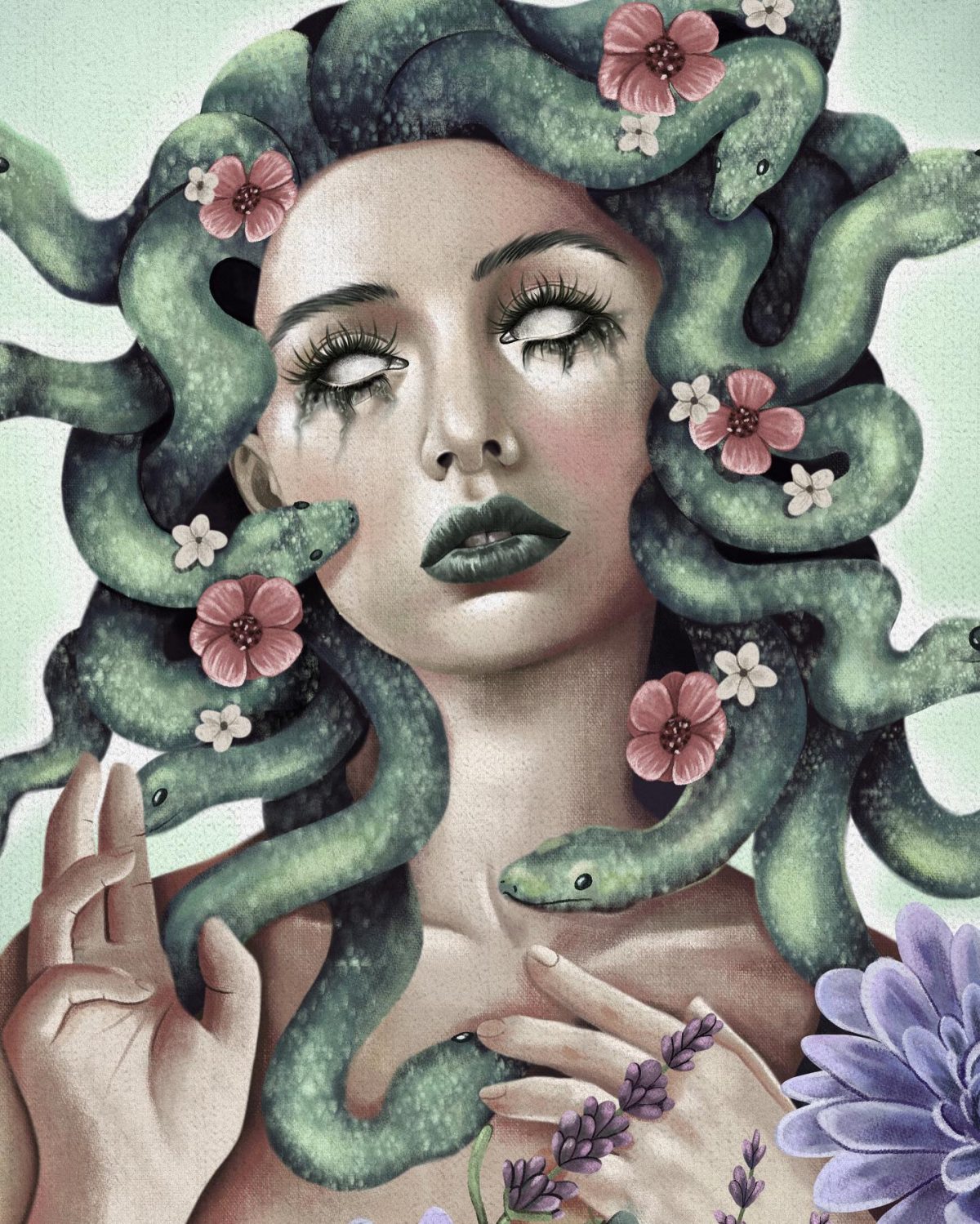
Look up different types for inspiration. A viper has a distinct, triangular head and a thicker body, which can give Medusa a more aggressive look. A constrictor, like a python, is heavier and more muscular, giving her ‘hair’ a sense of weight. And the scales… that’s a big one. Here’s a pro tip: don’t try to draw every single scale. Instead, use patterns of lines to suggest the texture. This technique is called cross-hatching, which is just a fancy term for using overlapping sets of parallel lines to create shadow and form. Notice how scales are often smaller near the head and get bigger along the body. That tiny detail adds a ton of realism.
Setting Up Your Workspace: Tools and Materials
The right tools make the work so much more enjoyable. You don’t need the most expensive stuff on the market, but a few quality items are way better than a drawer full of cheap supplies that just frustrate you. Here’s a peek at what’s on my drawing table.
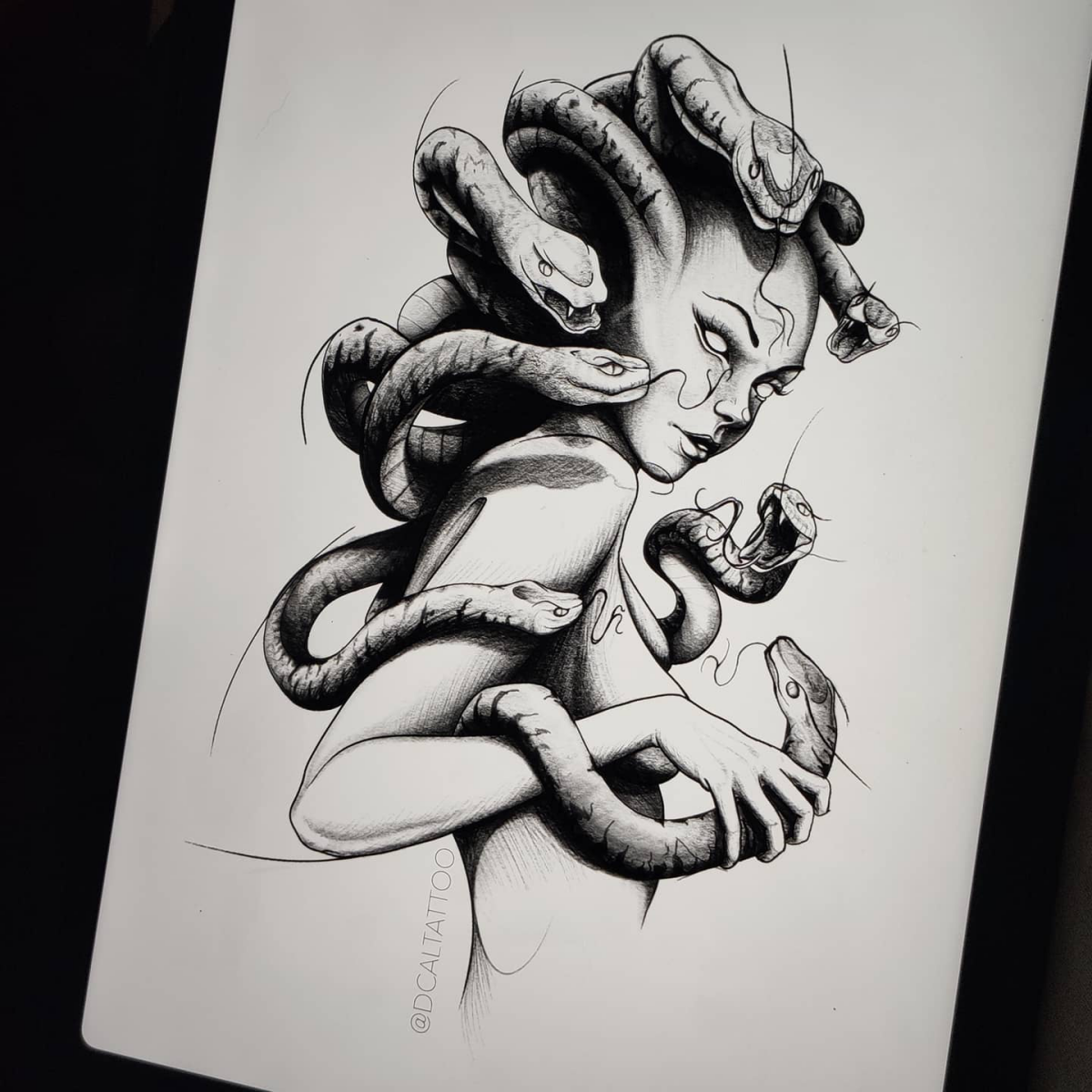
Your Beginner’s Shopping List
Let’s make this easy. If you’re starting from scratch, here’s a simple kit that will get you going without breaking the bank:
- A basic sketchbook: Look for something around 120 gsm. It’s great for practice sketches and costs about $10-$15.
- A starter pencil set: If you’re on a tight budget, just grab a 2H (for light sketches), a 2B (for general lines), and a 6B (for dark shadows). This will cover all your bases for under $10.
- A kneaded eraser: This is a soft, putty-like eraser that’s perfect for lifting graphite without smudging or tearing your paper. An absolute must-have, and it only costs about $2.
- Blending stumps: These rolled paper sticks give you way more control for smooth shading than your finger (which has oils that can stain the paper). A small pack is usually under $5.
For more advanced work, I do recommend a couple of other things. A pad of smooth Bristol board (around 270 gsm) is amazing for final, detailed pieces. And a pen-style eraser, like the Tombow Mono Zero, is a game-changer for creating tiny, precise highlights—like the glint in an eye or on a single scale.
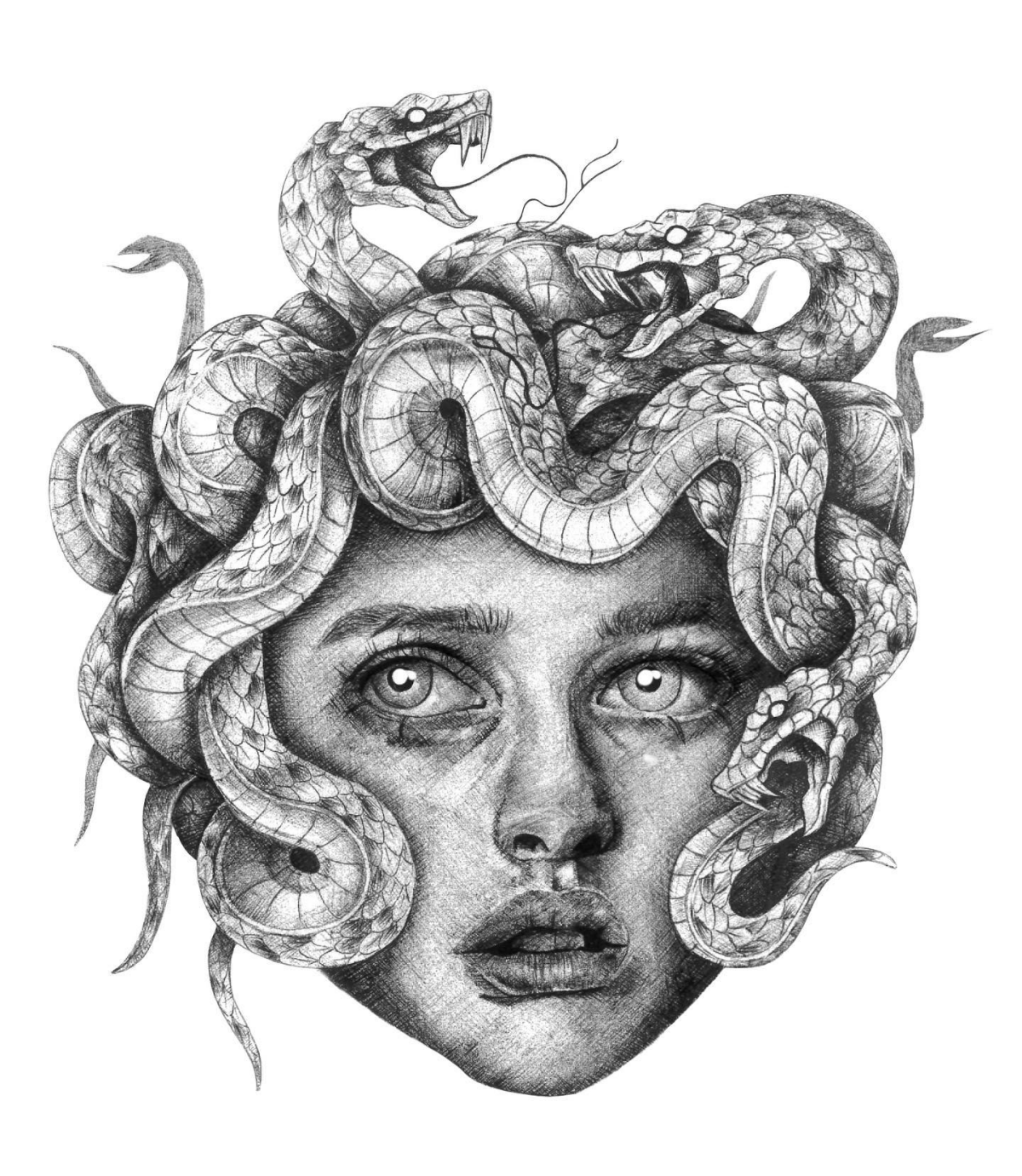
The Drawing Process: A Step-by-Step Method
Alright, let’s get to it. This is the process I follow for a detailed Medusa portrait. I break it down into manageable stages so it doesn’t feel so overwhelming. The key is to move slowly. Rushing is the enemy of a good drawing.
Step 1: Blocking in the Foundational Forms
(Estimated time: 30-45 minutes)
Grab your 2H pencil and keep your lines super light. Start with a sphere for the cranium. Then, add a line down the center for symmetry and a horizontal line across the middle for the eyes. This is a classic method pros use to make sure features land in the right spot. Next, sketch in the jawline and the basic shape of the neck and shoulders. You’re just building a simple mannequin right now—no details!
Step 2: Placing and Shaping the Facial Features
(Estimated time: 30 minutes to 2 hours)
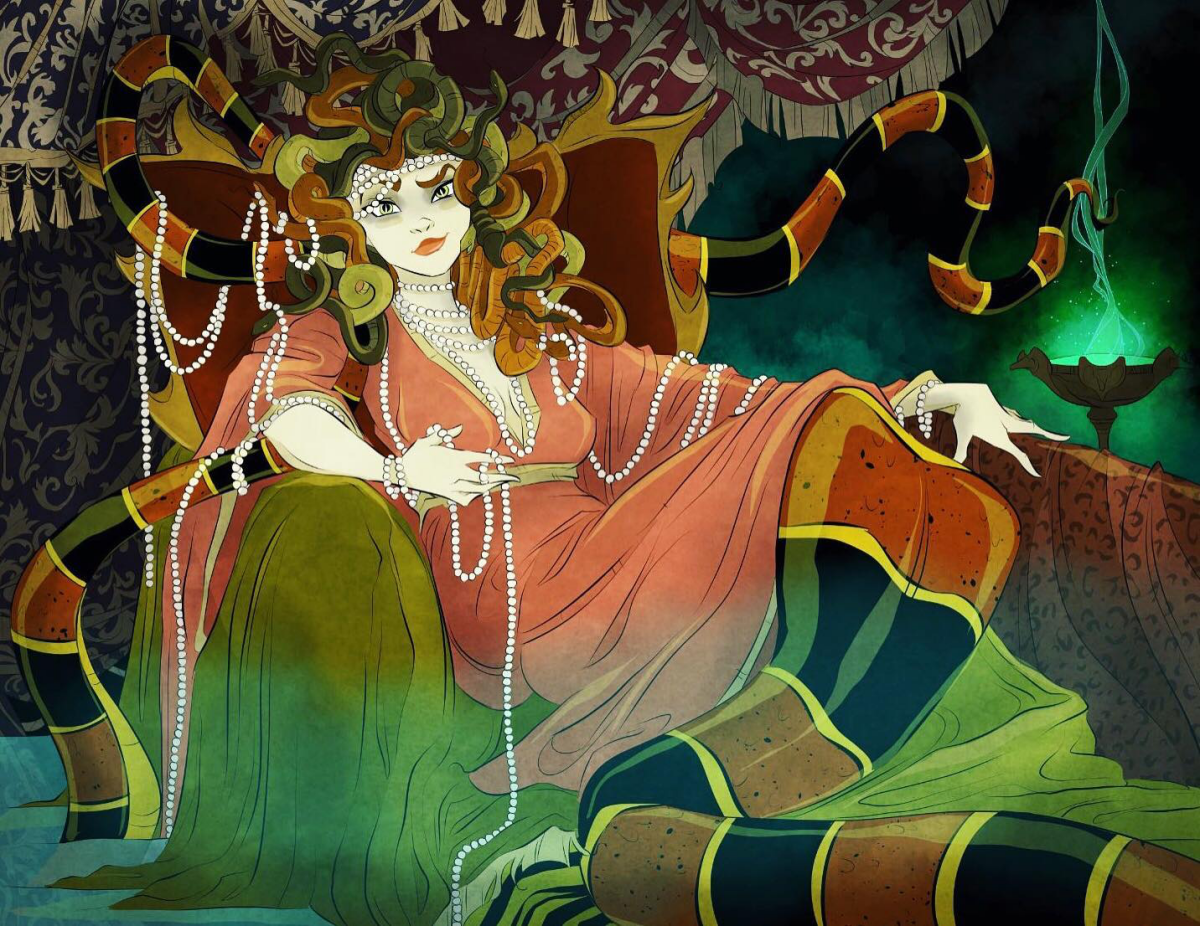
Switch to an HB pencil. Using your guidelines, lightly sketch the almond shapes for the eyes. A common mistake is drawing them too big or too close—the space between the eyes should be about the width of one eye. Sketch the nose and mouth. Now, the story begins. Furrow her brows in anger. Part her lips in a silent scream. I once spent an entire afternoon just adjusting the curve of a lip. This stage requires patience, so pour yourself some coffee and settle in.
Step 3: Designing the Mass of Snakes
(Estimated time: 45-60 minutes)
Before you draw a single snake, think of the hair as one large shape. What’s the overall silhouette? Does it flow to one side? Rise up like a crown? Lightly sketch this main shape first. Once you have that, start pulling individual snakes from the mass. A classic comic artist trick is to draw 3-5 big ‘hero’ snakes first that define the overall form. Then, you can fill in the space around them with the suggestion of smaller coils. This keeps it from looking like a chaotic plate of spaghetti.

Step 4 & 5: Refining Lines and Building Value with Shading
(Estimated time: 3-5+ hours)
This is where the magic happens, and it’s also the longest part of the process. With a 2B pencil, start refining your lines and adding details like eyelids. For the snakes, use cross-hatching to suggest scales, focusing on a few detailed ones up close.
Then, determine your light source. A single, dramatic light from the side or above creates a great sense of mystery. Using your softer pencils (4B to 8B), slowly build up your shadows. Start with the large shadow areas, like under the jaw or in the eye sockets, and use your blending stump to smooth things out. Don’t forget cast shadows—a snake on her forehead will cast a small shadow on her skin. That’s what makes it feel real. Contrast is everything. The darkest darks right next to the lightest lights will make your drawing pop off the page.
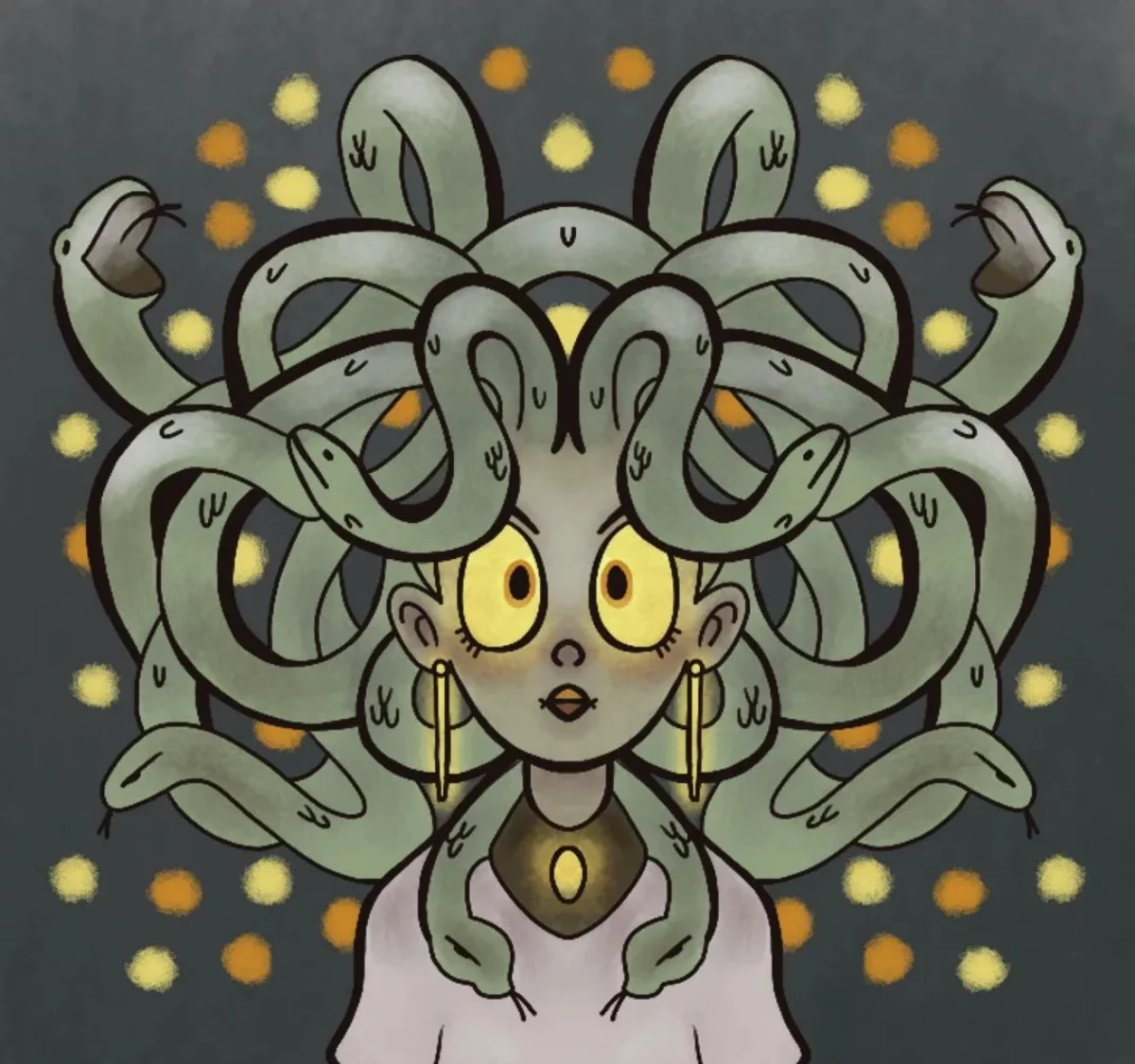
5-Minute Quick Win: Don’t have time for a full portrait? Try this now: Just draw one single snake. Focus on how its body tapers and how the scales wrap around the form. It’s a fantastic way to practice texture in just a few minutes.
Exploring Different Interpretations
Your Medusa doesn’t have to look like anyone else’s. Your artistic choices can tell a completely different story.
- The Nightmare Fuel Version: Early classical art often showed Medusa as a grotesque monster with a wide grin and tusks. This style is all about horror, using harsh, graphic lines. It’s a great fit for bold ink work.
- The Tragic Victim: Later on, artists began portraying her as a beautiful woman who was cursed. To capture this, focus on a sorrowful expression—think realistic tears and tense facial muscles. The snakes might seem more sad than aggressive.
- The Modern Symbol of Power: Today, many see Medusa as a symbol of female rage and survival. This version is often defiant, with a direct, unflinching gaze right at the viewer. The composition is confrontational and powerful.
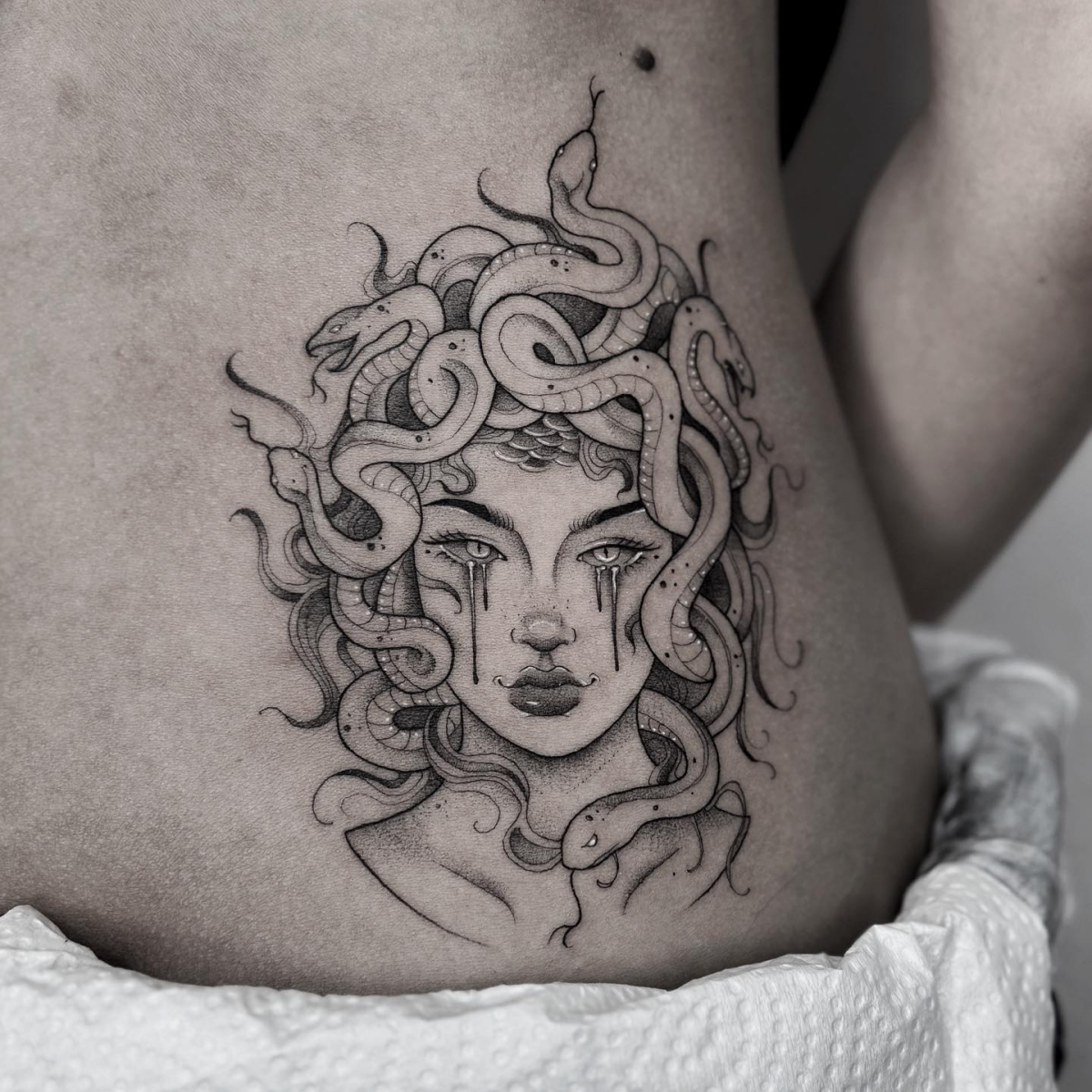
Advanced Tips and Troubleshooting
Once you’ve got the basics down, you’ll inevitably run into a few common problems. Here’s how to fix them.
Galerie d’inspiration
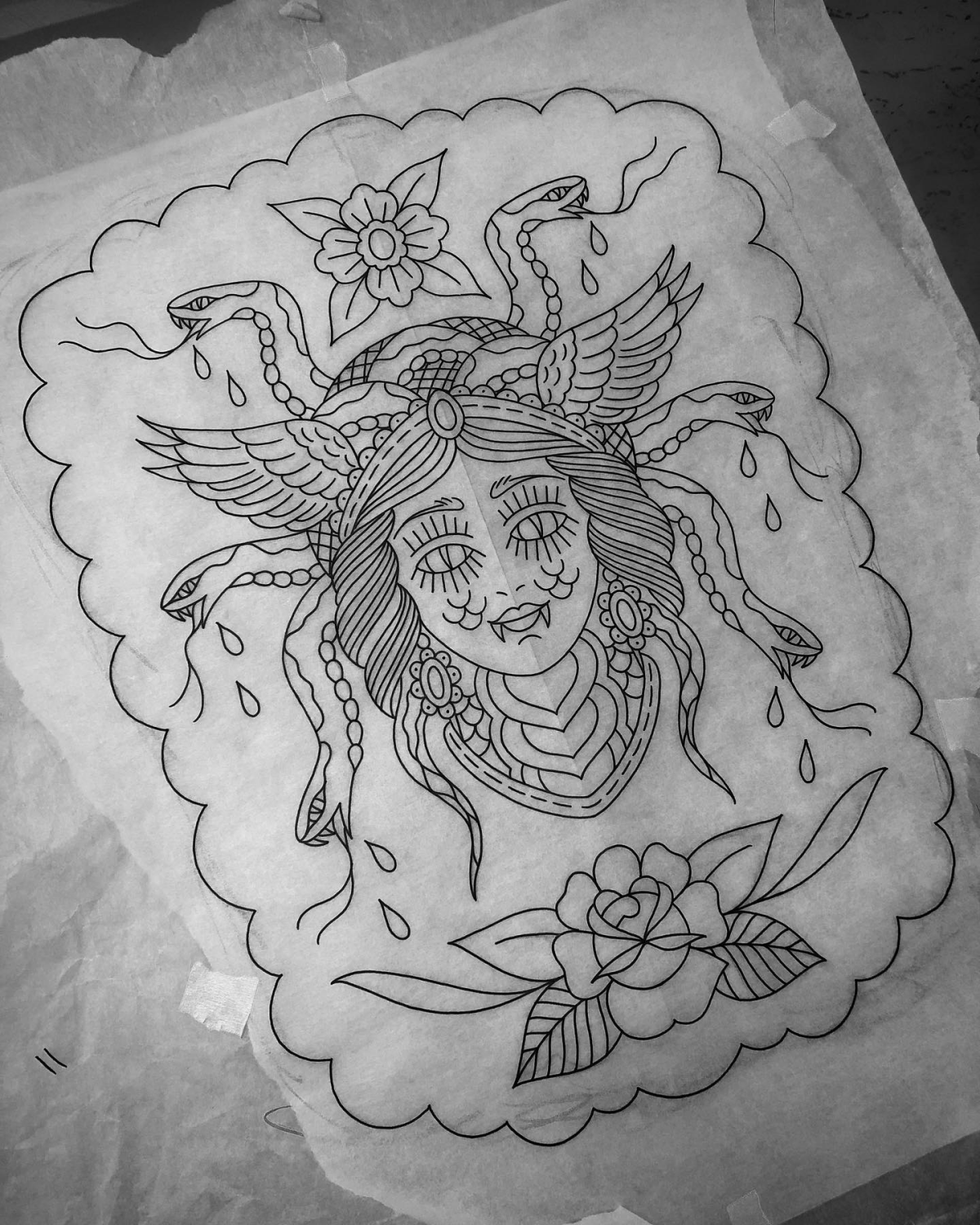
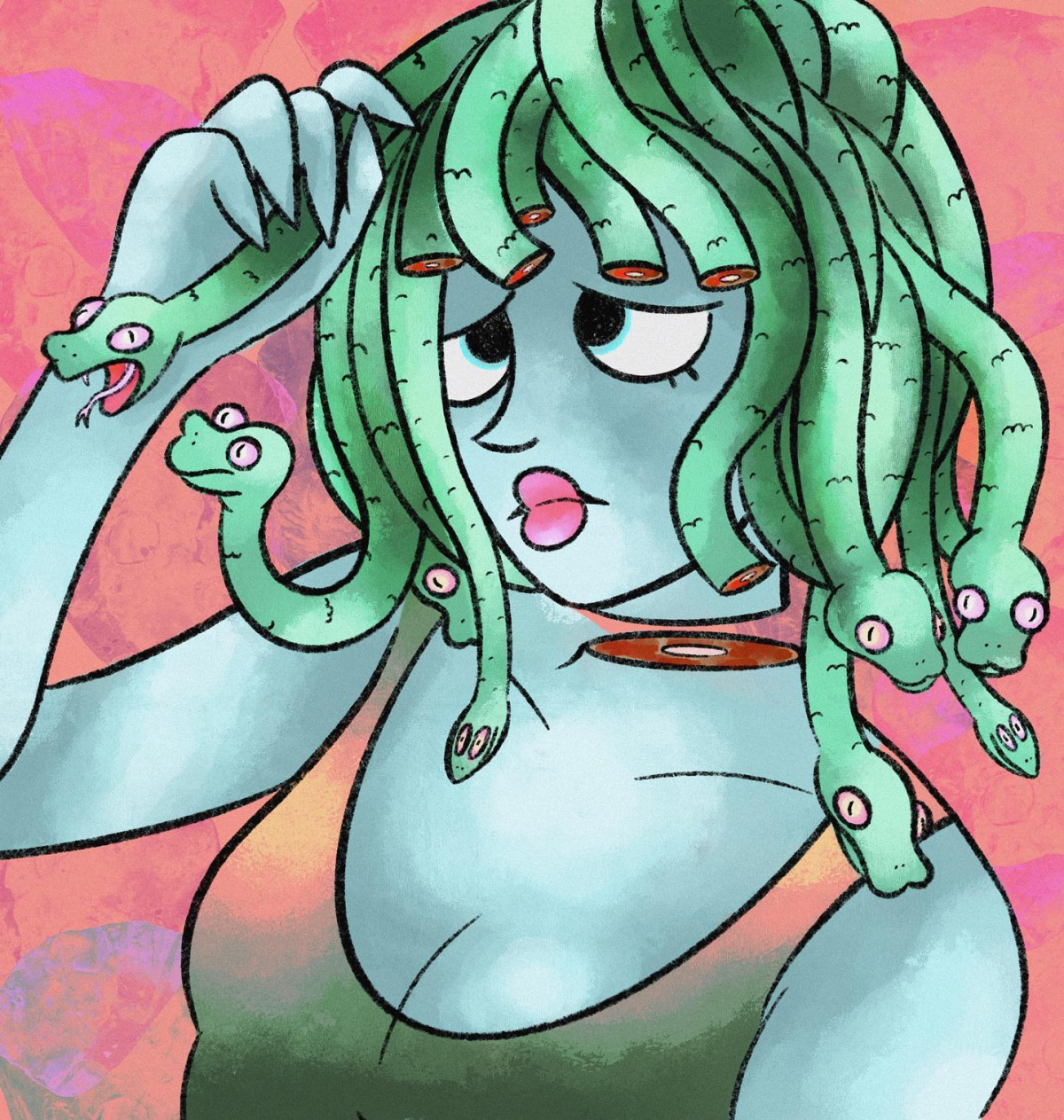
When drawing Medusa’s snakes, think beyond simple tubes. Look at real-life references. A viper’s triangular head and heat-sensing pits add menace. A cobra’s hood can frame the face dramatically. A python’s muscular thickness suggests immense power. Mixing these features creates a crown that feels alive and truly dangerous, not just like a pile of generic serpents.
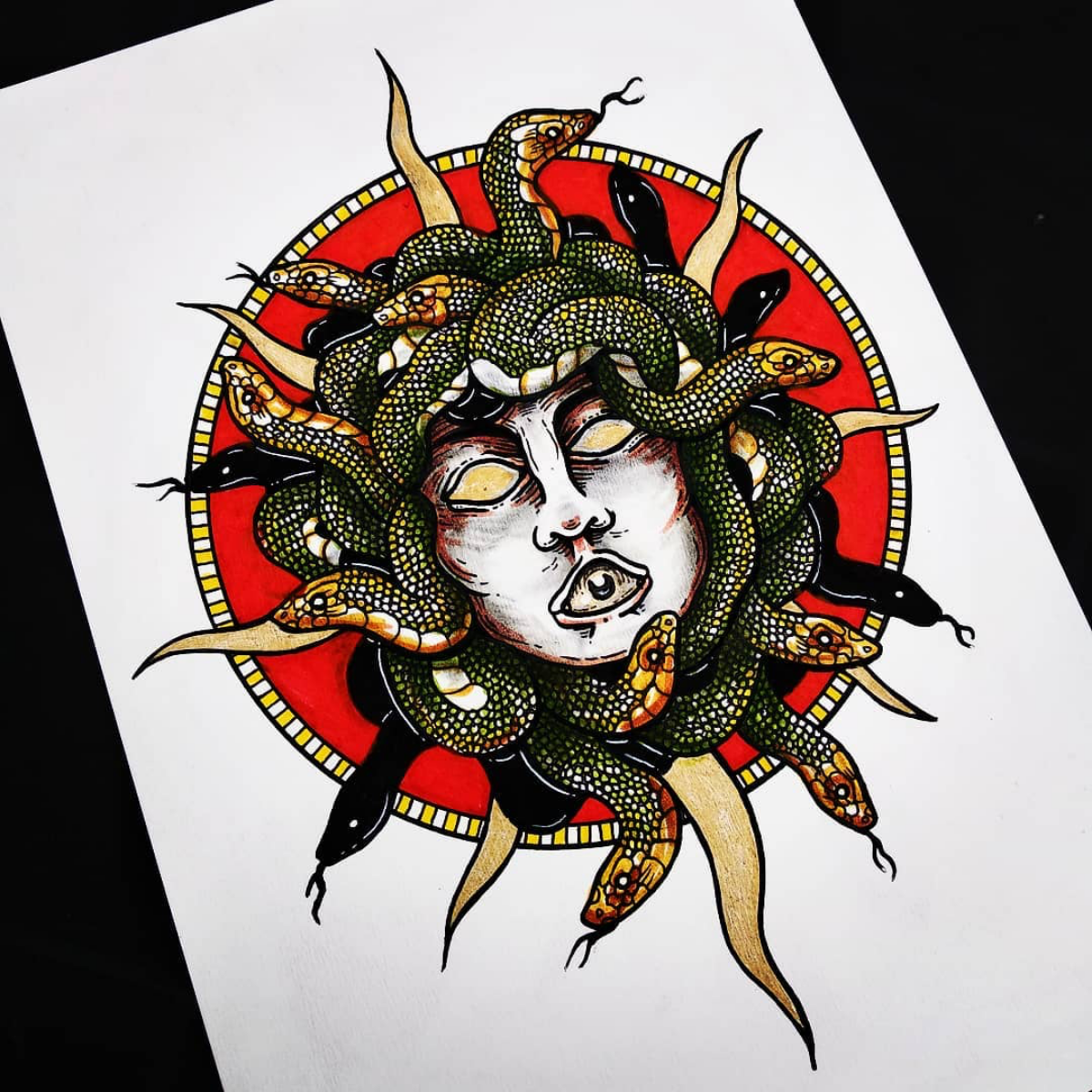
- Vary the thickness and length of each snake to create visual rhythm.
- Use ‘S’ curves and coils instead of straight lines to imply movement and energy.
- Show some snakes overlapping and disappearing behind others to give a sense of depth and mass.
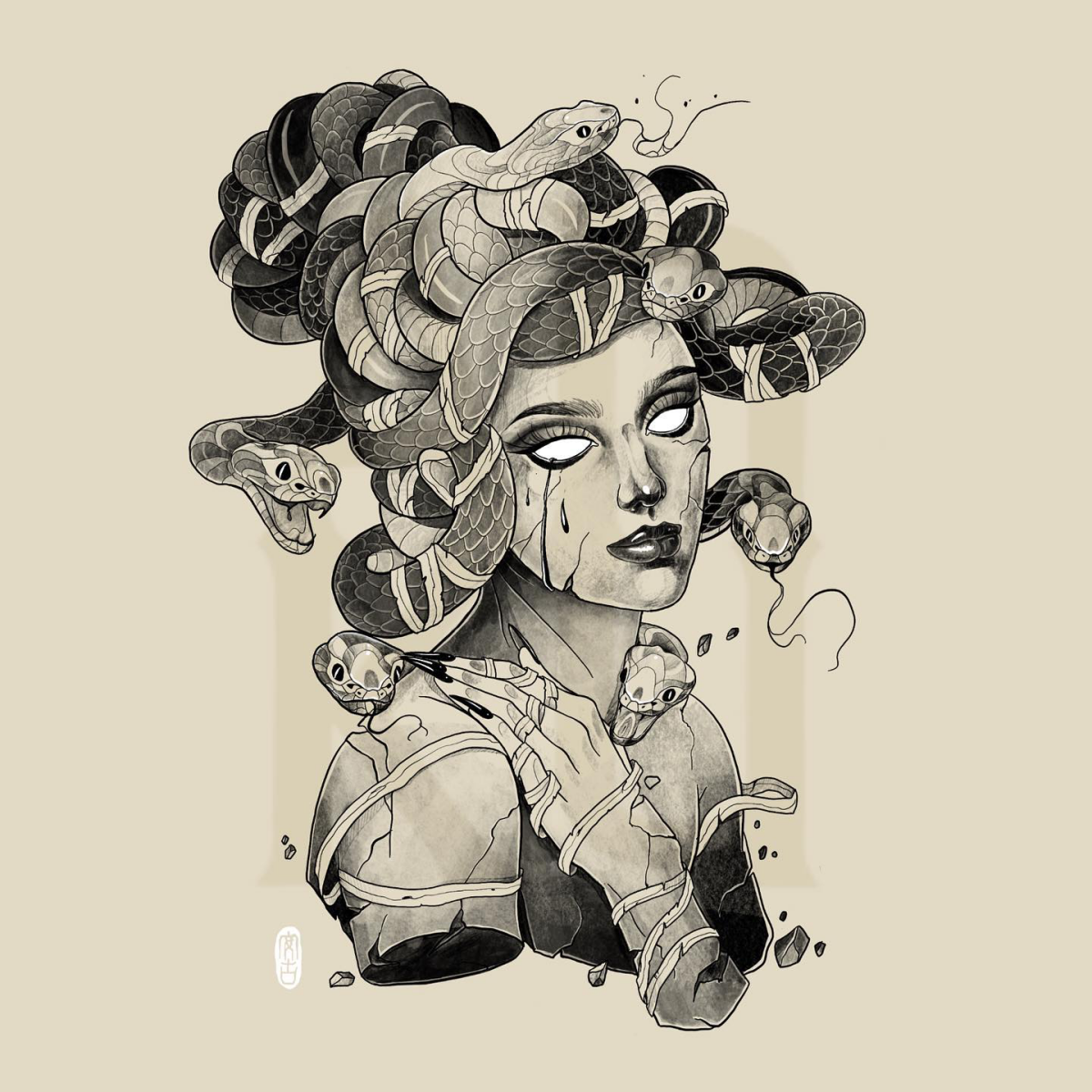
The secret to a compelling Medusa is contrast. Don’t just focus on the scales; perfect the texture of her skin. Use smooth, subtle blending for her face—perhaps with a graphite pencil like a Tombow Mono—and then switch to sharp, defined cross-hatching or stippling for the scales. This tactile difference makes both elements pop and feels more believable to the viewer.
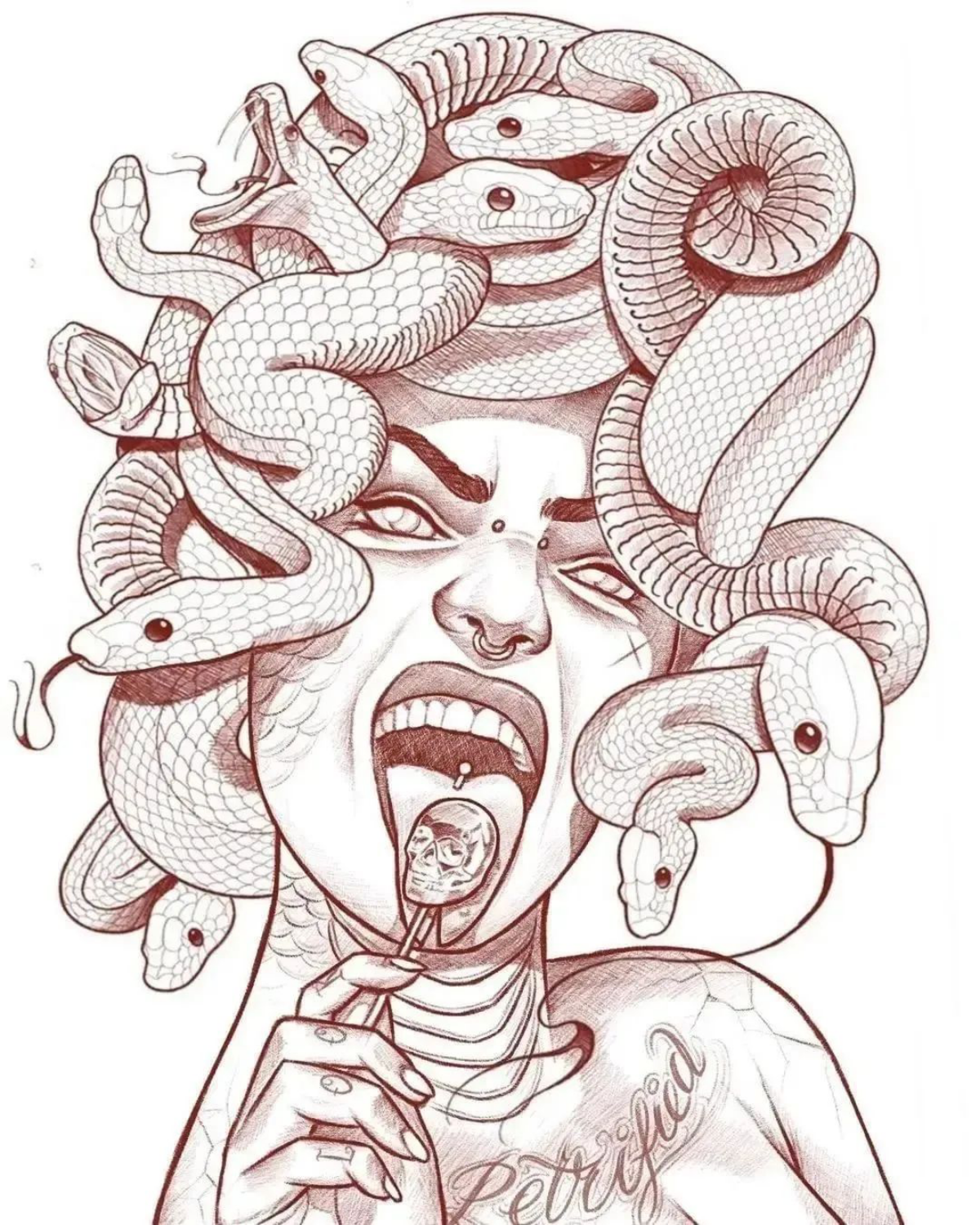
Caravaggio’s 1597 masterpiece, Medusa, was famously painted on a ceremonial shield. He used his own face as the model, capturing a moment of horrified self-realization as Medusa sees her reflection just as she is slain.
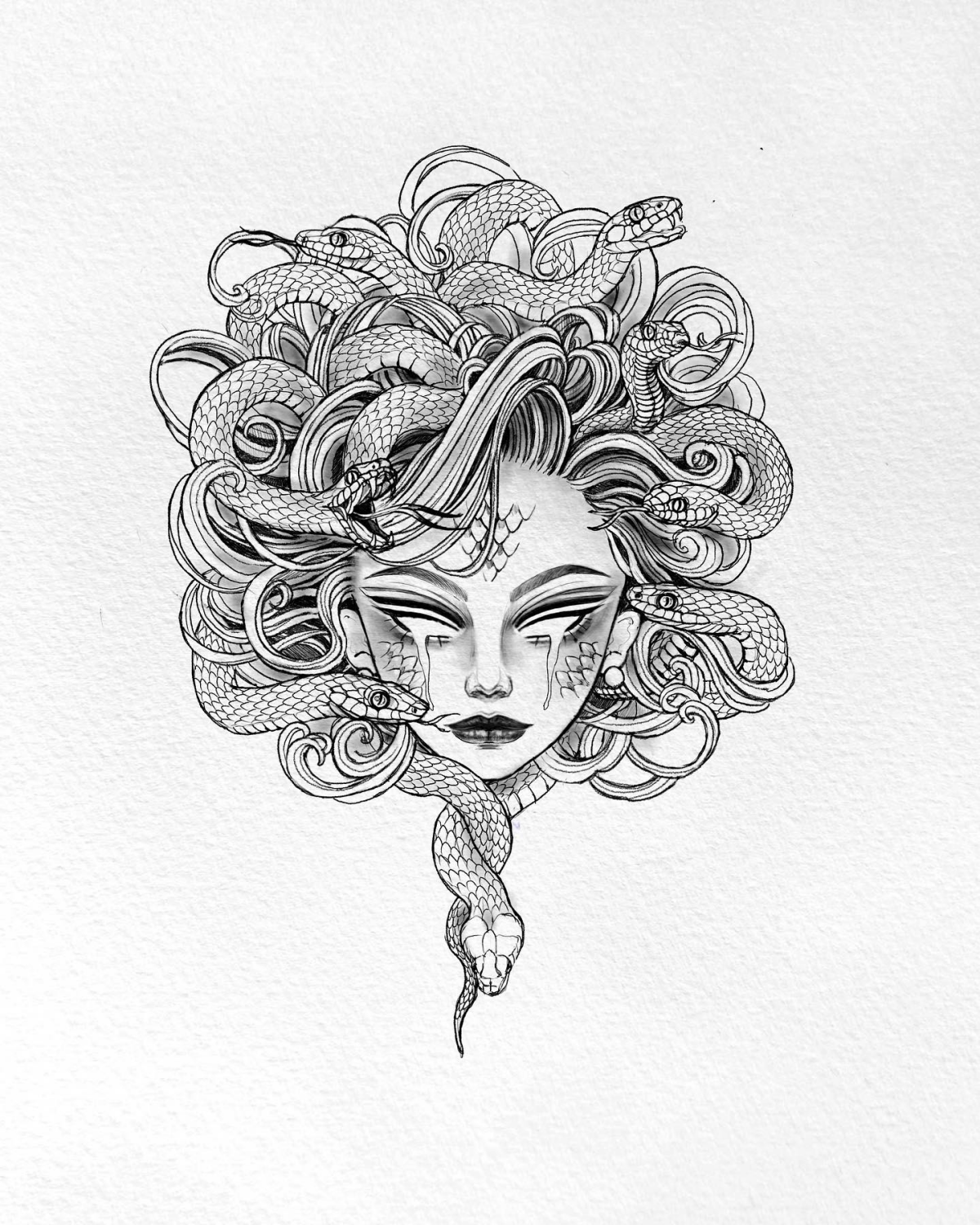
How do you make the scales look shiny and three-dimensional?
It’s all about mastering light and shadow. Don’t outline every single scale. Instead, use a soft graphite pencil (like a 4B) to block in the shadow areas of the snake’s body first. Then, use a kneaded eraser or a white gel pen, like a Sakura Gelly Roll, to pick out the highlights where the light hits the curve of each scale. This creates a much more realistic, iridescent effect than simple lines ever could.
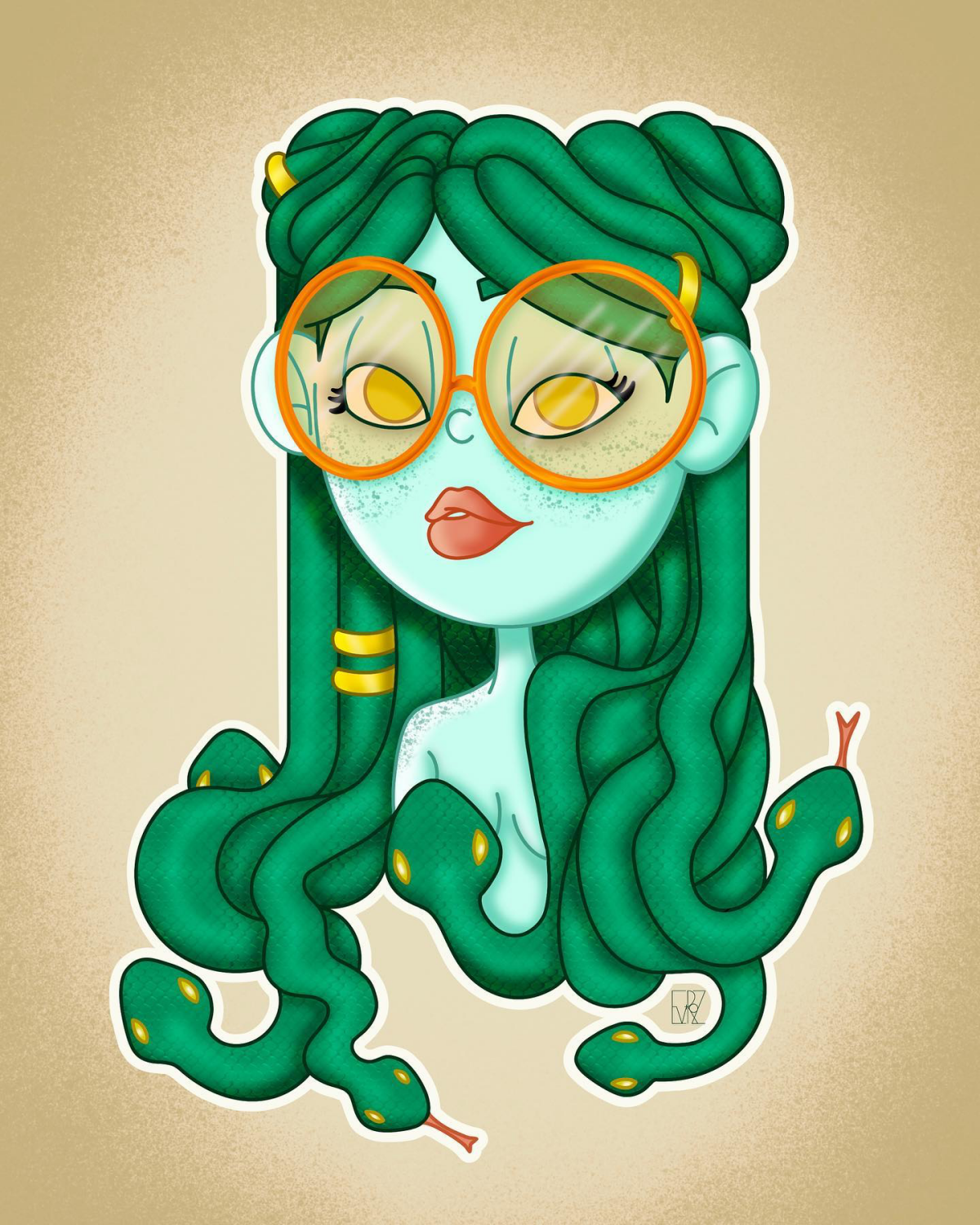
Thinking about your medium is key. For a gritty, tragic Medusa, the texture of charcoal on heavyweight paper like Strathmore 500 Series is unmatched. For a vibrant, graphic novel interpretation, the clean, super-saturated lines of Copic Multiliner pens followed by their alcohol markers will give you that professional, polished look. The tool itself is part of the story.
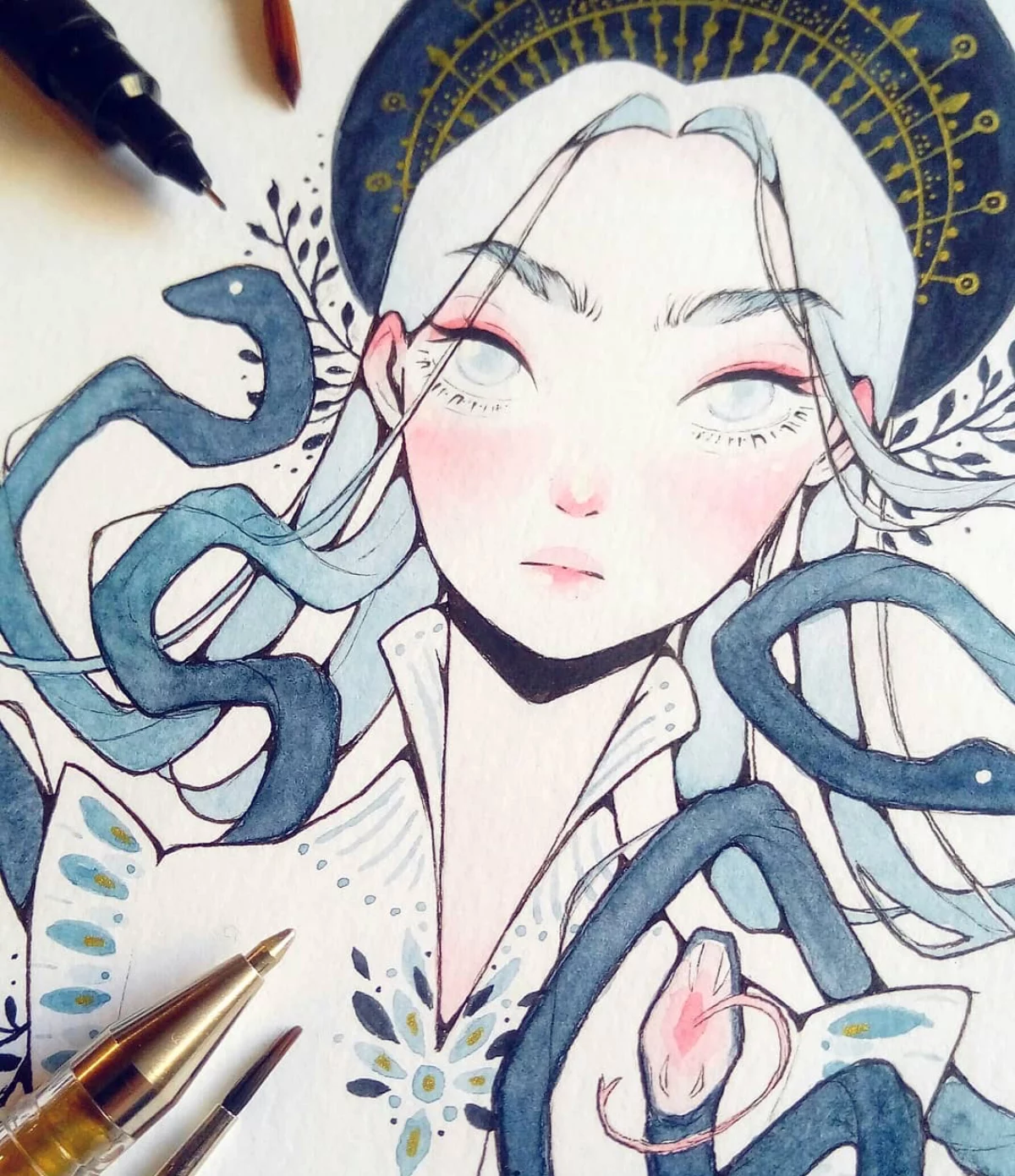
Graphite Pencils: Excellent for subtle gradients and realistic skin textures. They allow for easy erasing and correction, making them ideal for initial anatomical studies.
Charcoal Sticks: Perfect for high-drama, intense shadows, and a more raw, expressive style. They are harder to control but offer deeper blacks and a powerful emotional impact.
For a piece that balances realism and emotion, consider starting with graphite and adding charcoal for the deepest shadows and snakes.

- A defiant, upturned chin.
- Eyes wide with sorrow, not just rage.
- A mouth slightly open, caught between a gasp and a hiss.
The key to a powerful Medusa is her expression. Is she a monster, a victim, or a warrior? Before you draw a single scale, decide on the emotion you want to convey. Her story is written on her face.
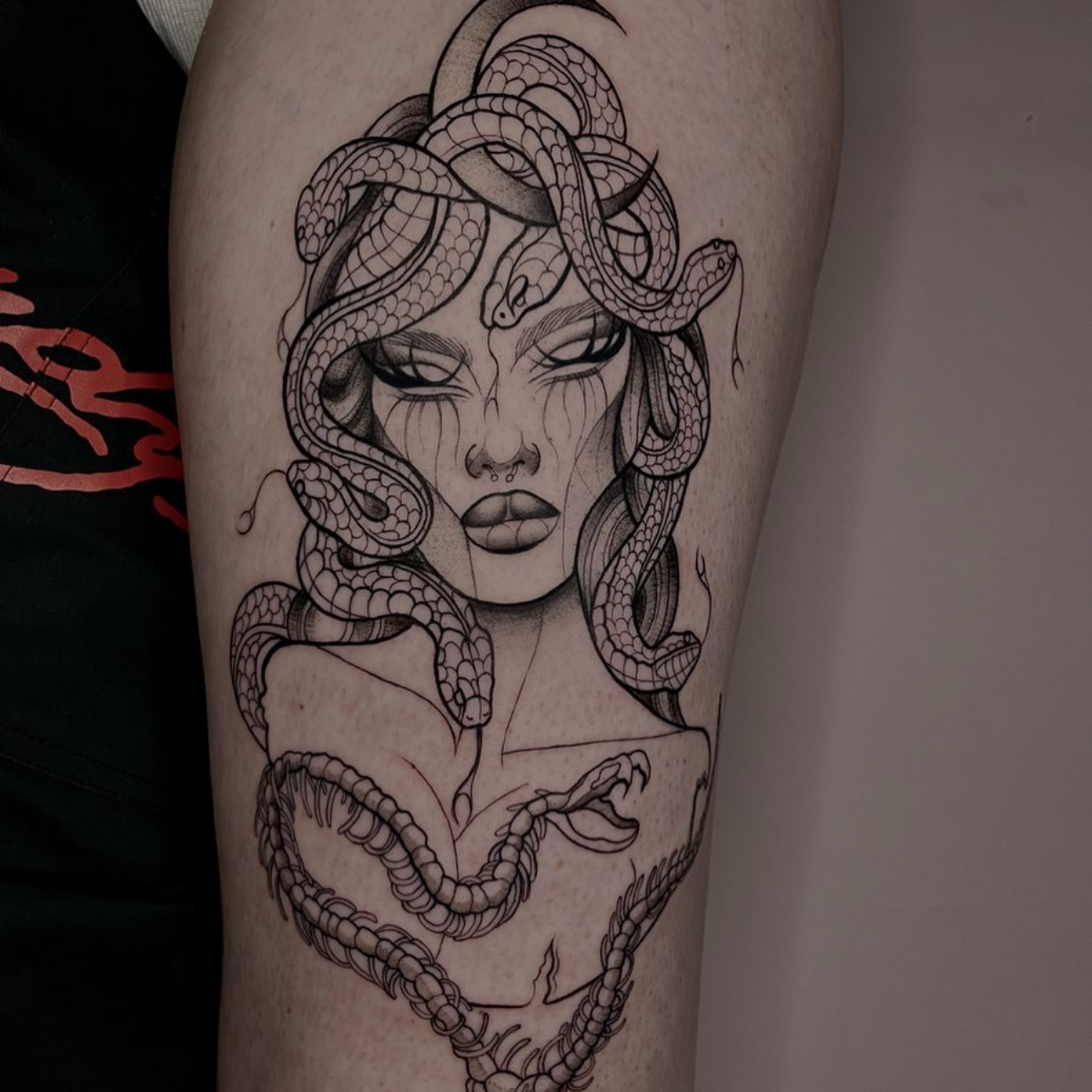
There are over 3,000 species of snakes in the world. Only about 600 are venomous.
This biological fact is a goldmine for creativity. It means your Medusa doesn’t have to have only vipers for hair. You can include the beautiful, non-venomous patterns of a corn snake, the sleekness of a garter snake, or the sheer size of a boa constrictor. This variety will make your creation more visually interesting and unique.
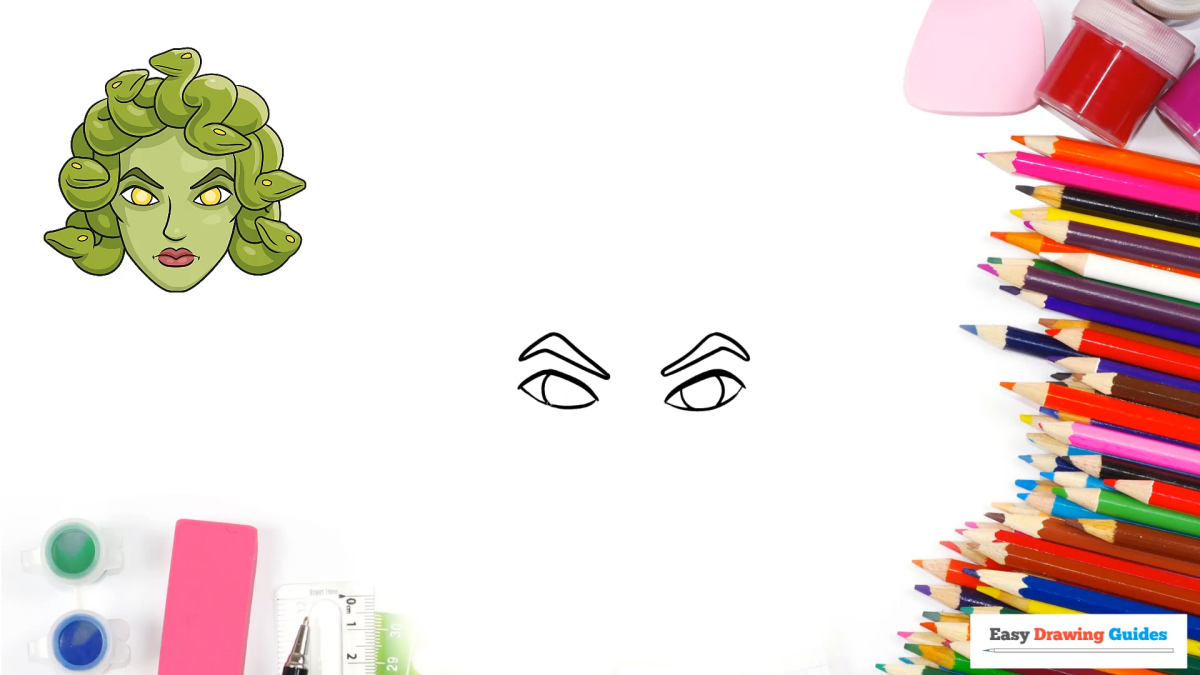
Don’t let the snakes become a uniform ‘helmet.’ A common mistake is drawing them all symmetrically or heading in the same direction. Let a few snakes break the silhouette, one curling down near her cheek, another hissing directly toward the viewer. This asymmetry is what breathes life and chaos into the character.
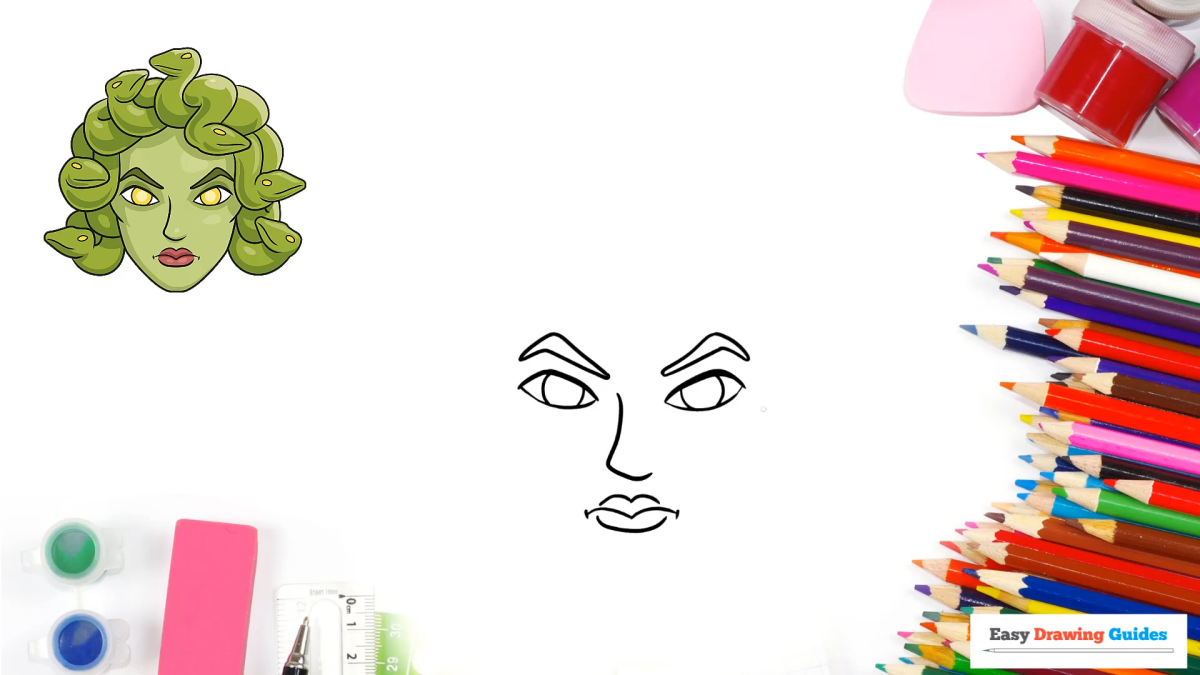
Considering a digital approach?
The right brushes are everything. For Procreate, try the ‘Serpent’ or ‘Scales’ brushes from a creator like Jingsketch for quick texturing. In Photoshop, a custom dual brush with a scaly texture and scattering enabled can create a whole head of snakes in minutes. Don’t forget to work in layers: one for the face, one for the main snake forms, and another for highlights and shadows.
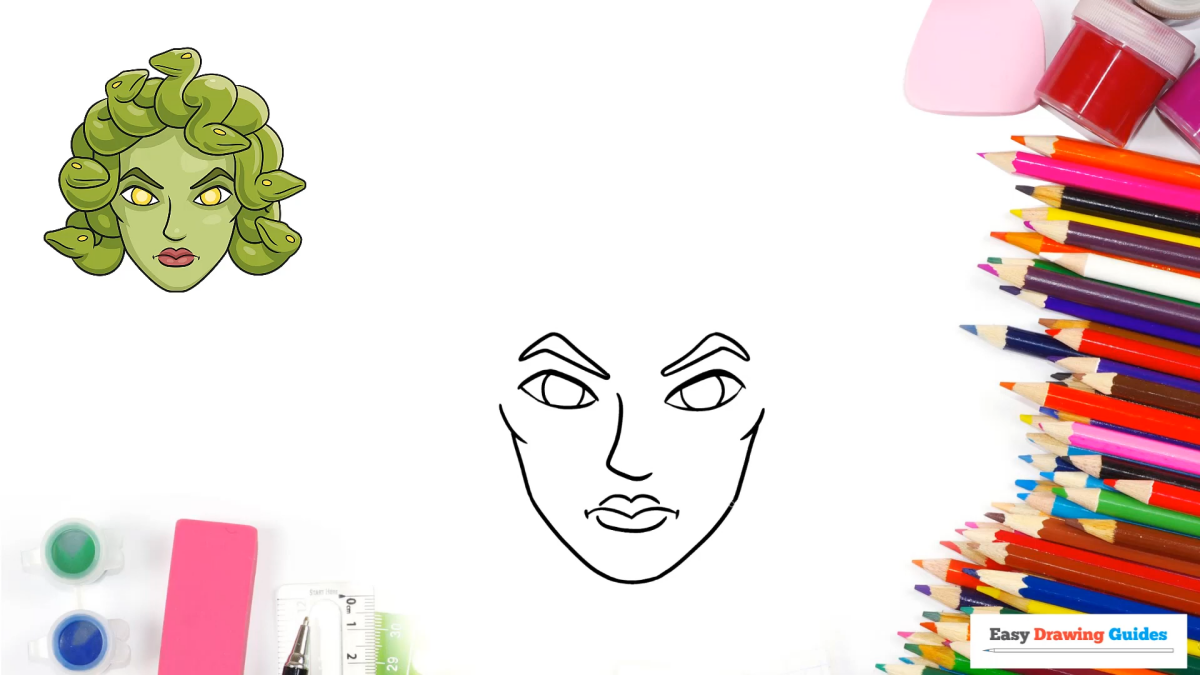
“Medusa is the archetypal female nightmare. She is the terrifyingly beautiful, beautiful-in-her-terror, woman.” – Art Historian, Griselda Pollock
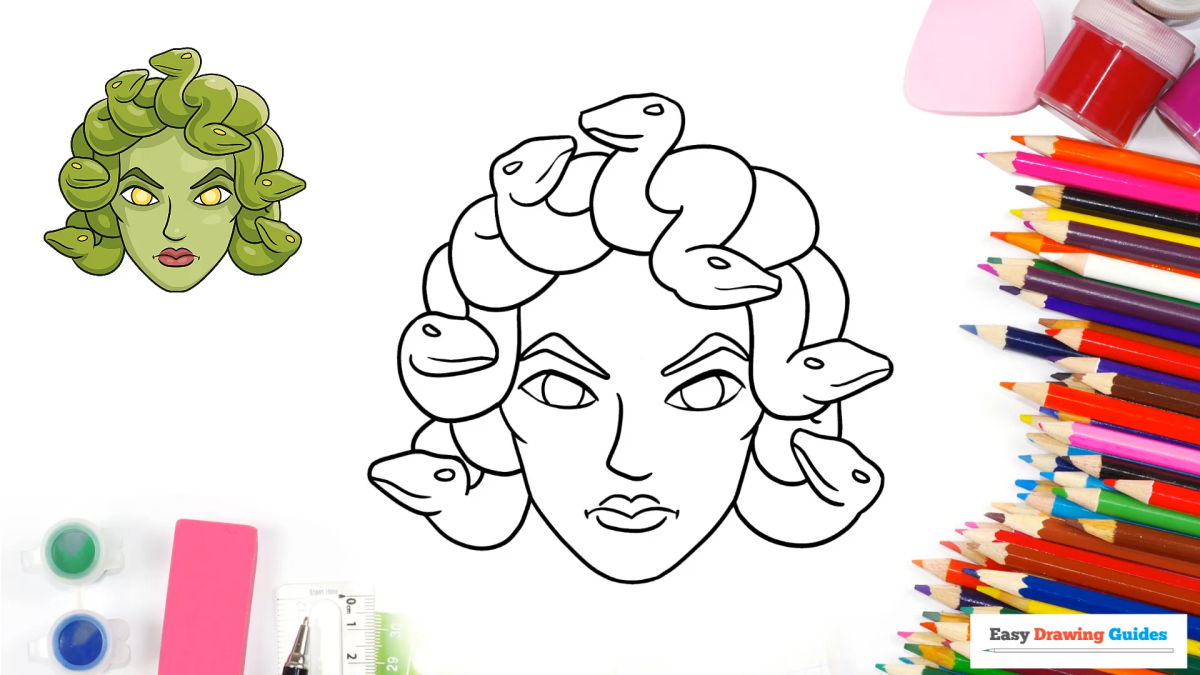

A modern trend: Many contemporary artists, especially in tattoo culture, are reimagining Medusa not as a monster, but as a symbol of feminine rage and a protector of victims. This interpretation often focuses on her sorrow and defiance, a powerful shift from her classical depiction as a terrifying villain.
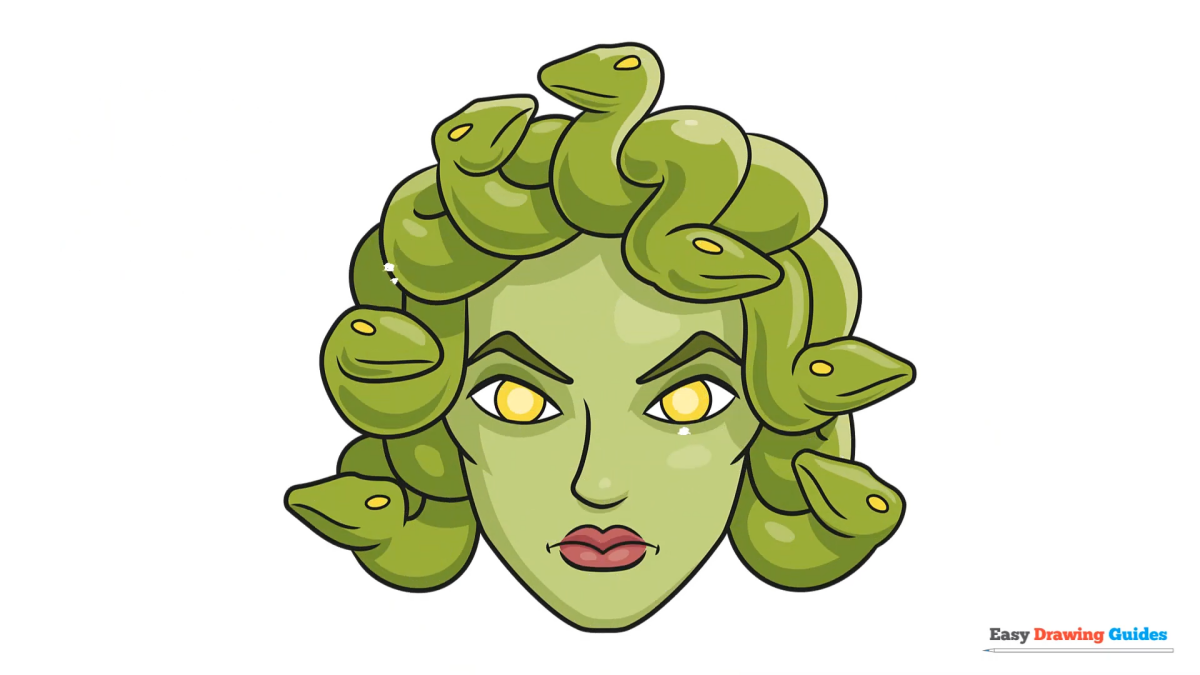
Go beyond a simple portrait. Framing your Medusa can amplify her story.
- Reflection: Draw her reflection in Perseus’s polished shield, a moment of tragic self-awareness.
- Environment: Place her in crumbling Greek ruins, emphasizing her isolation and the passage of time.
- Victims: Hint at her power by showing the base of a petrified statue just inside the frame.
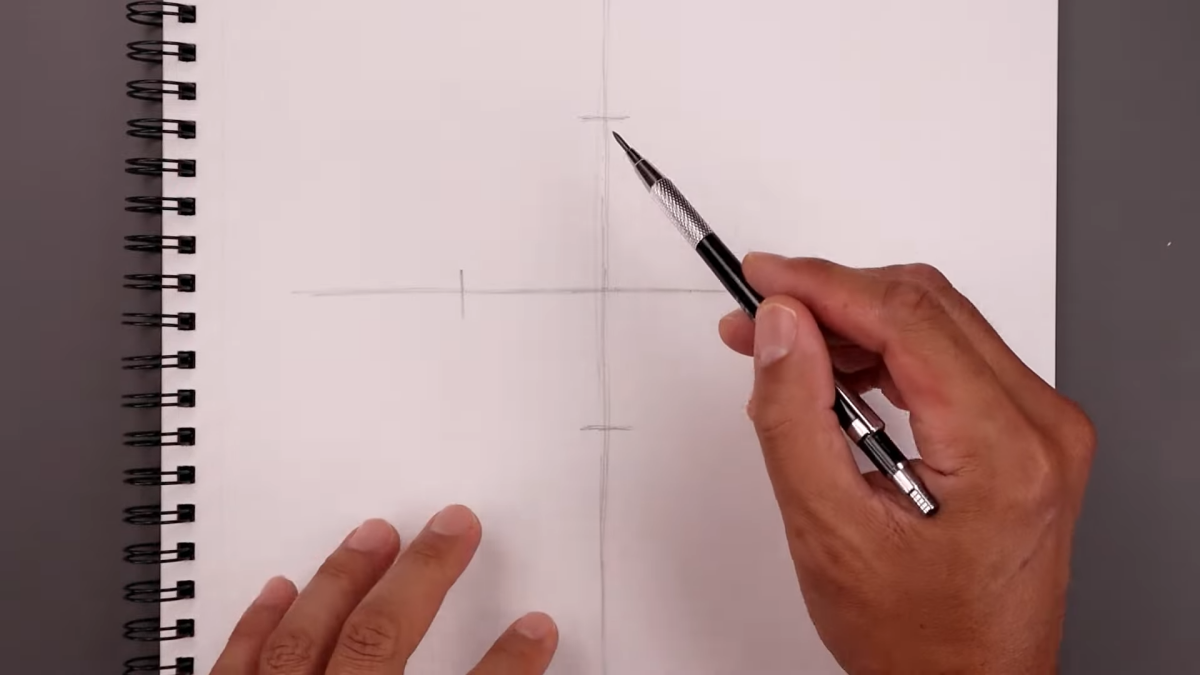
Art Nouveau Medusa: Think Alphonse Mucha. Use long, flowing, decorative lines. The snakes would be stylized, weaving into intricate patterns with her hair and background elements. The mood is more ethereal and beautiful than horrific.
Hyperrealism Medusa: Focus on intense detail. Every scale, pore, and tear duct is rendered with photographic precision. This style emphasizes the creature’s physical reality, making her both fascinating and deeply unsettling.
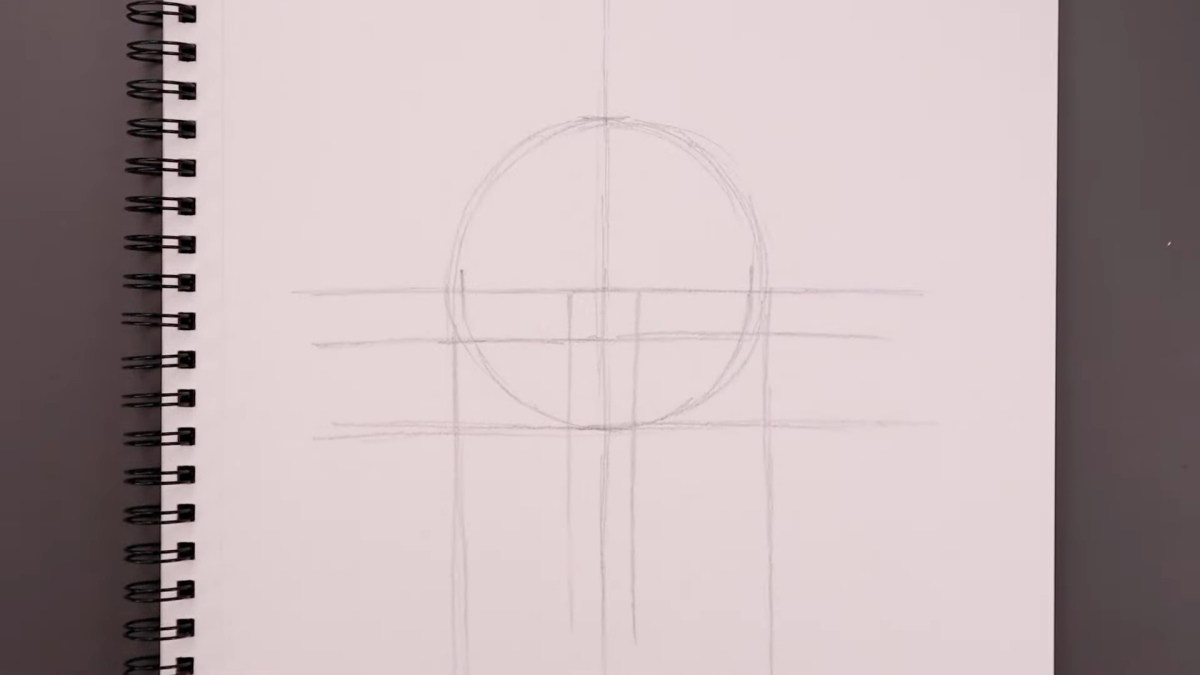
For creating those tiny, perfect highlights on snake scales or a glint in the eye, nothing beats a fine-point white gel pen. While an eraser can lift graphite, a pen like the Uni-ball Signo Broad adds a bright, opaque pop of white that sits on top of graphite, ink, or marker. It’s the final 1% that makes the drawing feel truly alive.
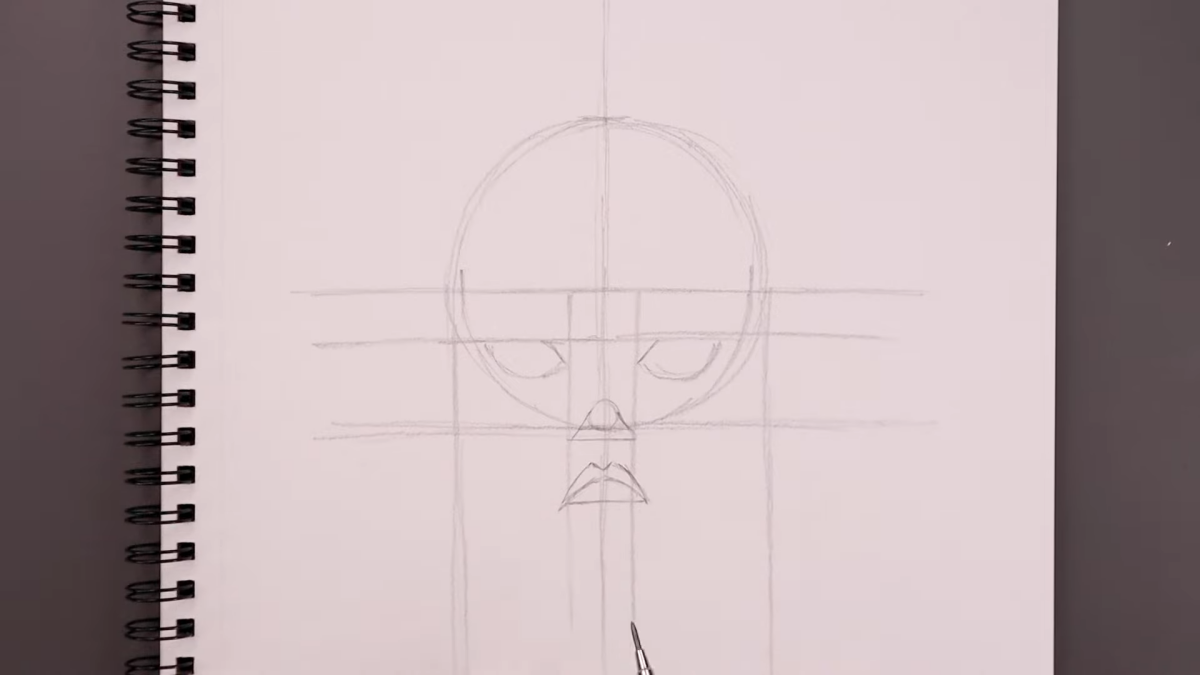
In Ovid’s ‘Metamorphoses,’ Medusa was a beautiful priestess in the temple of Athena, who was assaulted by Poseidon. Athena, in a fit of rage and jealousy, punished Medusa by turning her hair into snakes and cursing her to turn any who looked at her to stone. Drawing with this tragic backstory in mind can lead to a more empathetic and complex portrait.
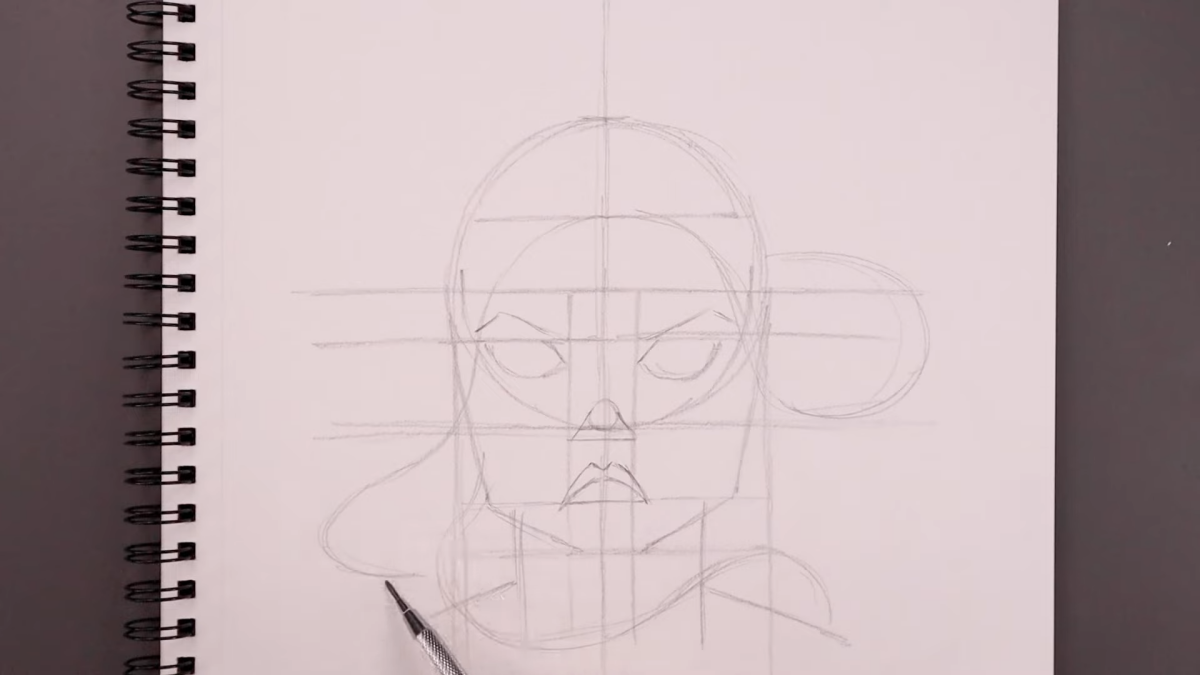
Your color palette is a narrative shortcut. A cold palette dominated by blues, deep greens, and purples can highlight her tragic, isolated nature. Conversely, a palette with fiery reds, oranges, and venomous yellows can portray her as a figure of pure rage and destructive power. Decide on her story before you pick your colors.
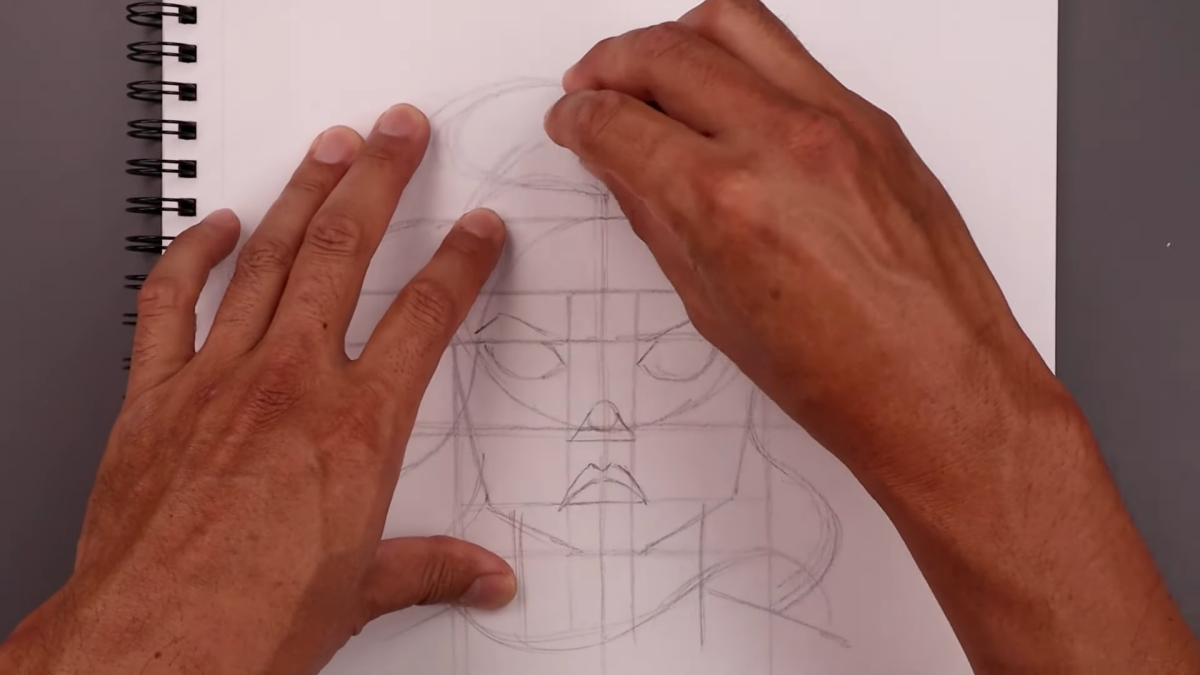
- Flawlessly smooth skin tones.
- Vibrant, saturated colors that pop off the page.
- Seamless blending without streaks.
The secret is often alcohol markers. While Copic is the industry standard, brands like Ohuhu and Winsor & Newton offer fantastic, more affordable alternatives for artists wanting to explore this vibrant medium without breaking the bank.
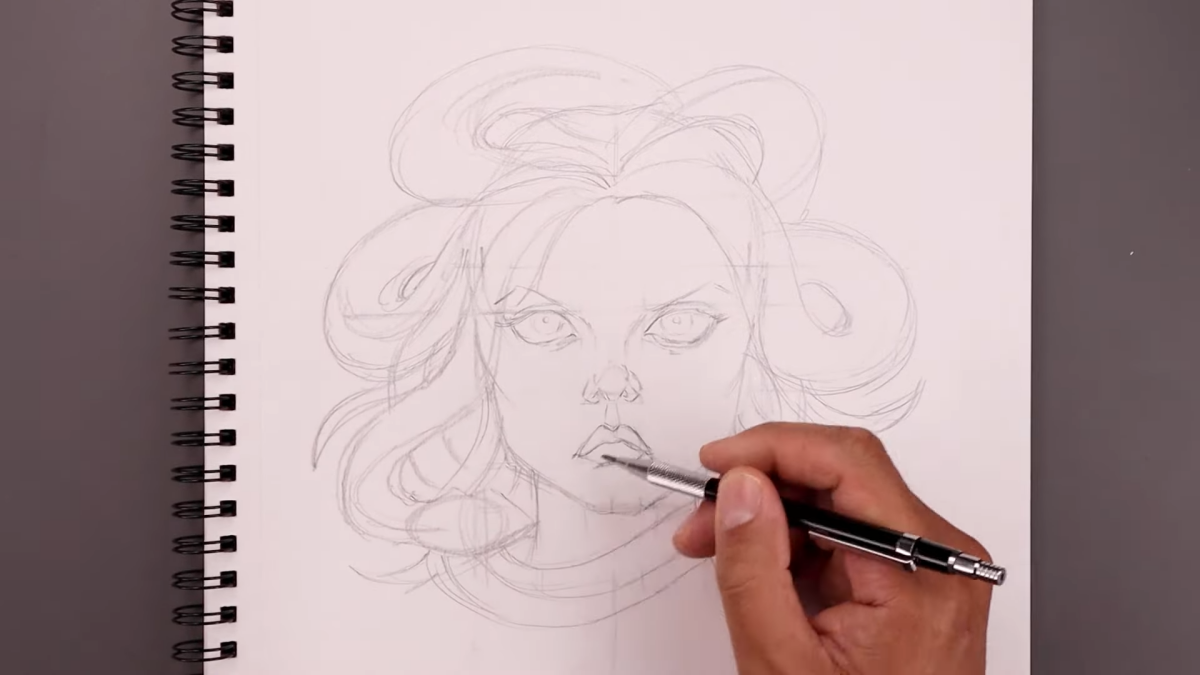
Important detail: The Gaze. Her curse is in her eyes. Don’t let them be an afterthought. Are they wide with the horror of her own condition? Are they narrowed with cold fury at the world? Or are they empty, devoid of all emotion after centuries of solitude? The direction and intensity of her gaze should be the anchor of your entire composition.
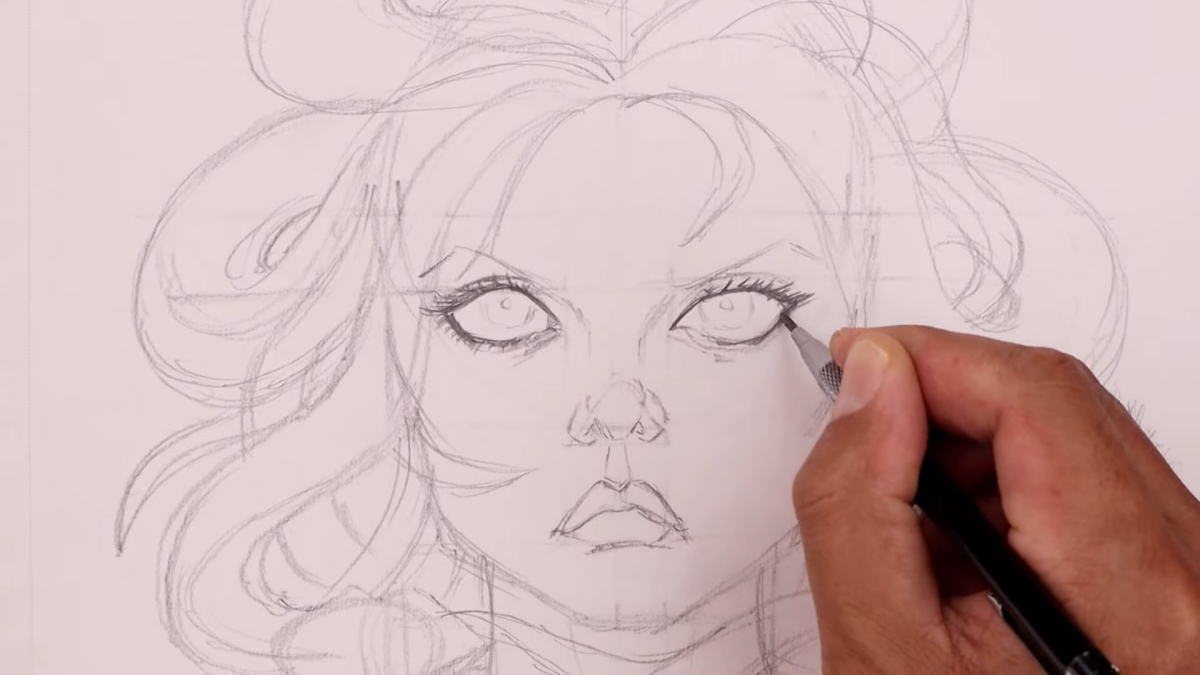
How do you handle the transition from soft skin to hard scales?
This is a classic texture challenge. A great technique is to use a soft, physical transition element. You can draw a few strands of her original hair twisting and morphing into snakes near the hairline. Alternatively, a decorative headband or tiara can create a clear, deliberate border between the human and the monstrous, allowing each texture to exist powerfully on its own.
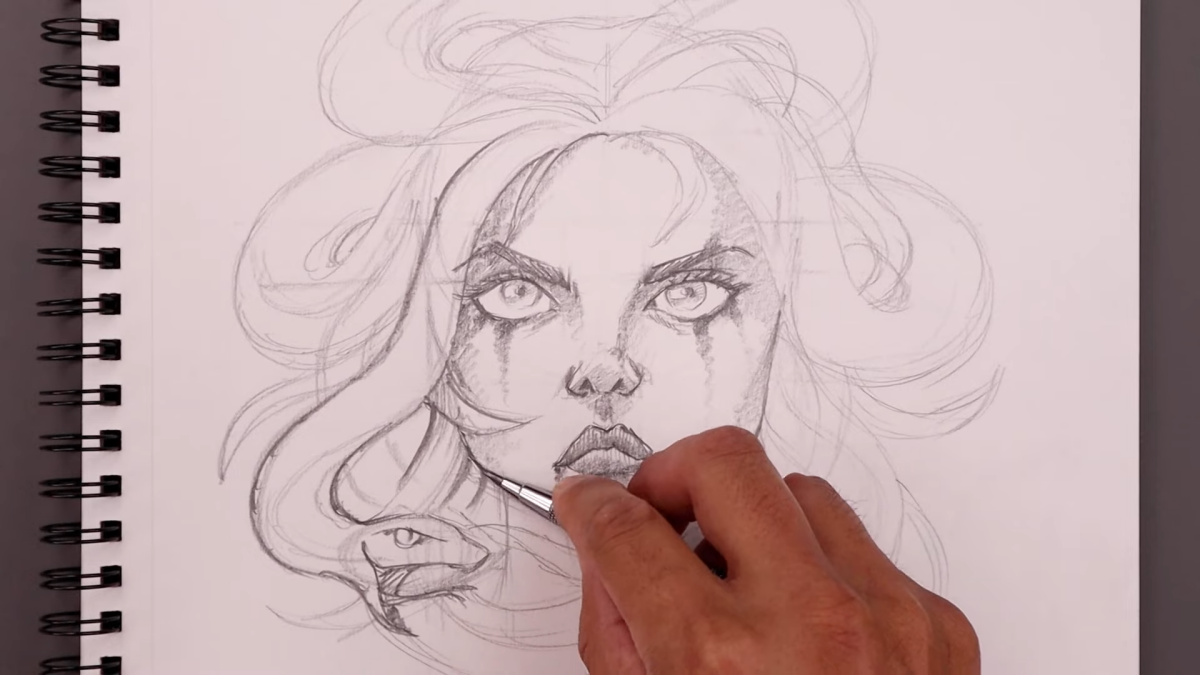
For dramatic, non-reflective shadows: A standard #2 pencil will always have a slight sheen when you press hard for dark areas. For truly deep, matte blacks that absorb the light, invest in a specialty pencil like the Blackwing Matte or the Faber-Castell Pitt Graphite Matte. They are designed to eliminate glare, giving your shadows immense depth, especially in photographs.
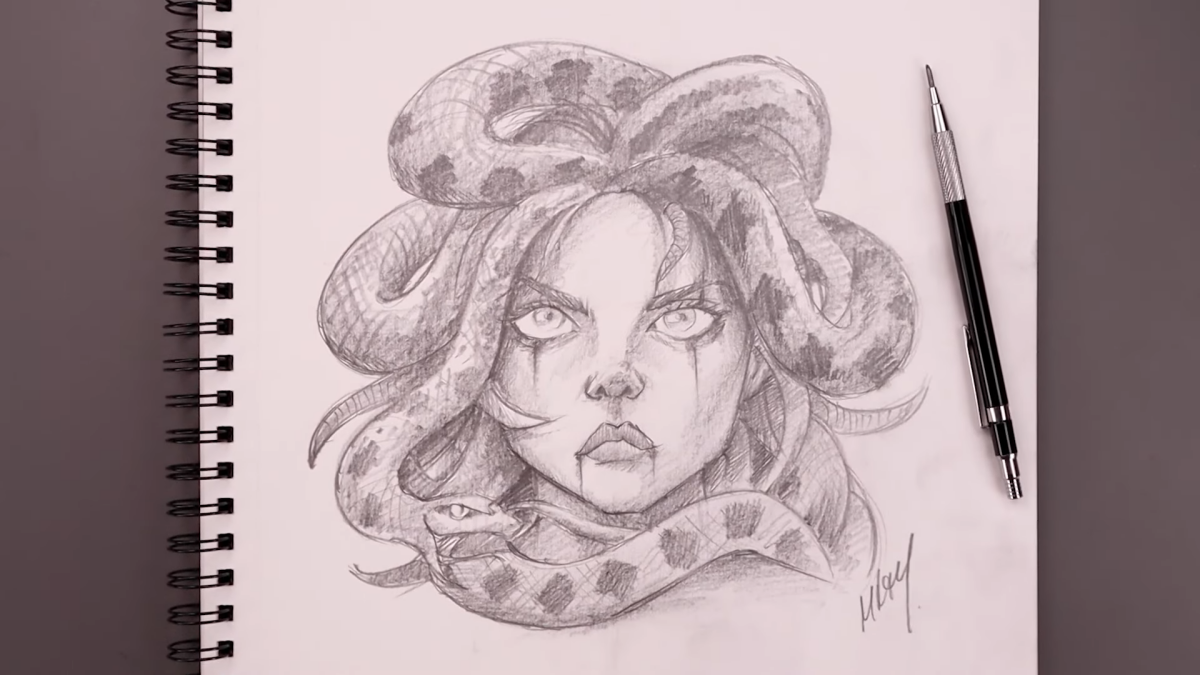
According to some versions of the myth, the blood that dripped from Medusa’s severed head sprang forth Pegasus, the winged horse, and Chrysaor, a giant with a golden sword.
This adds another layer to her character—creation from destruction. Imagine a composition where these figures emerge ethereally from her shadow or from the snakes themselves. It turns a simple portrait into a mythological epic.
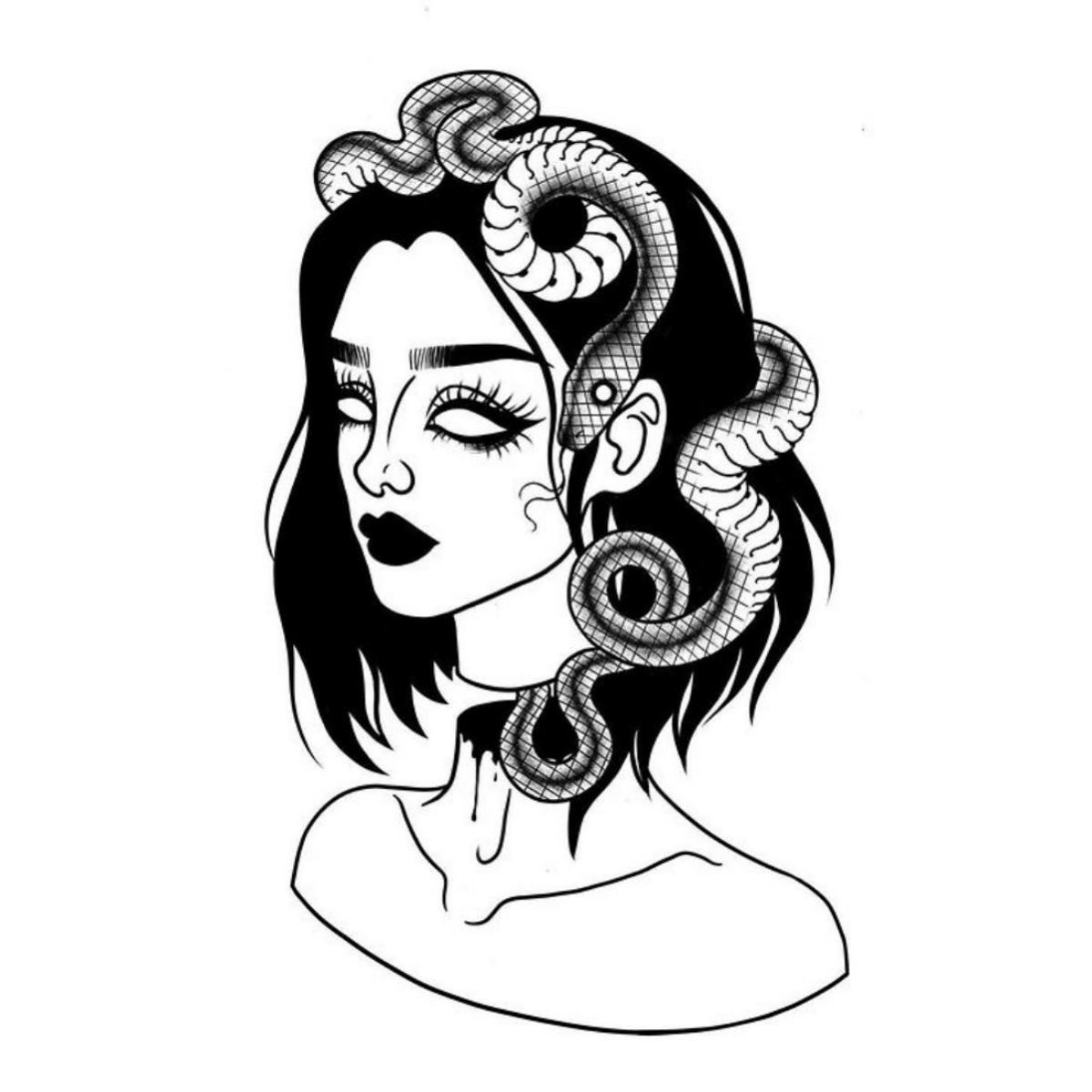
Don’t be afraid to break the mold. Your Medusa doesn’t have to be based on Greek sculpture. What would a Medusa inspired by Japanese Noh masks look like? Or one influenced by the aesthetics of Mayan or Aztec carvings? Fusing this classic myth with a different cultural art style can lead to a breathtakingly original creation.
Feeling stuck? Do a ‘texture study’ on a separate piece of paper. Don’t draw the whole face, just a small square. In that square, practice the transition from skin to scales. Try different pencils, pressures, and blending techniques. This low-stakes exercise can unlock the solution for your main piece without the fear of ‘ruining’ it.










